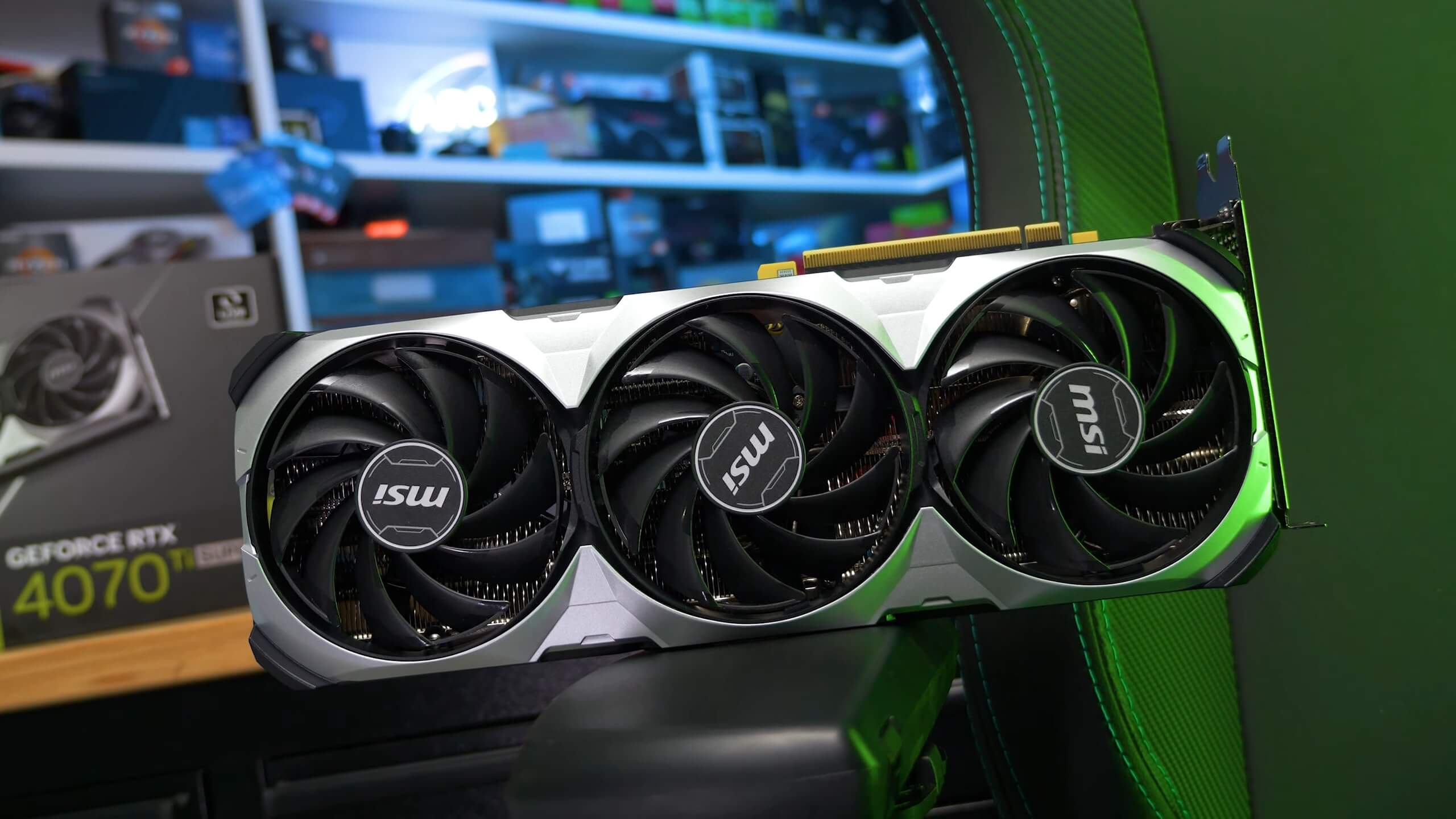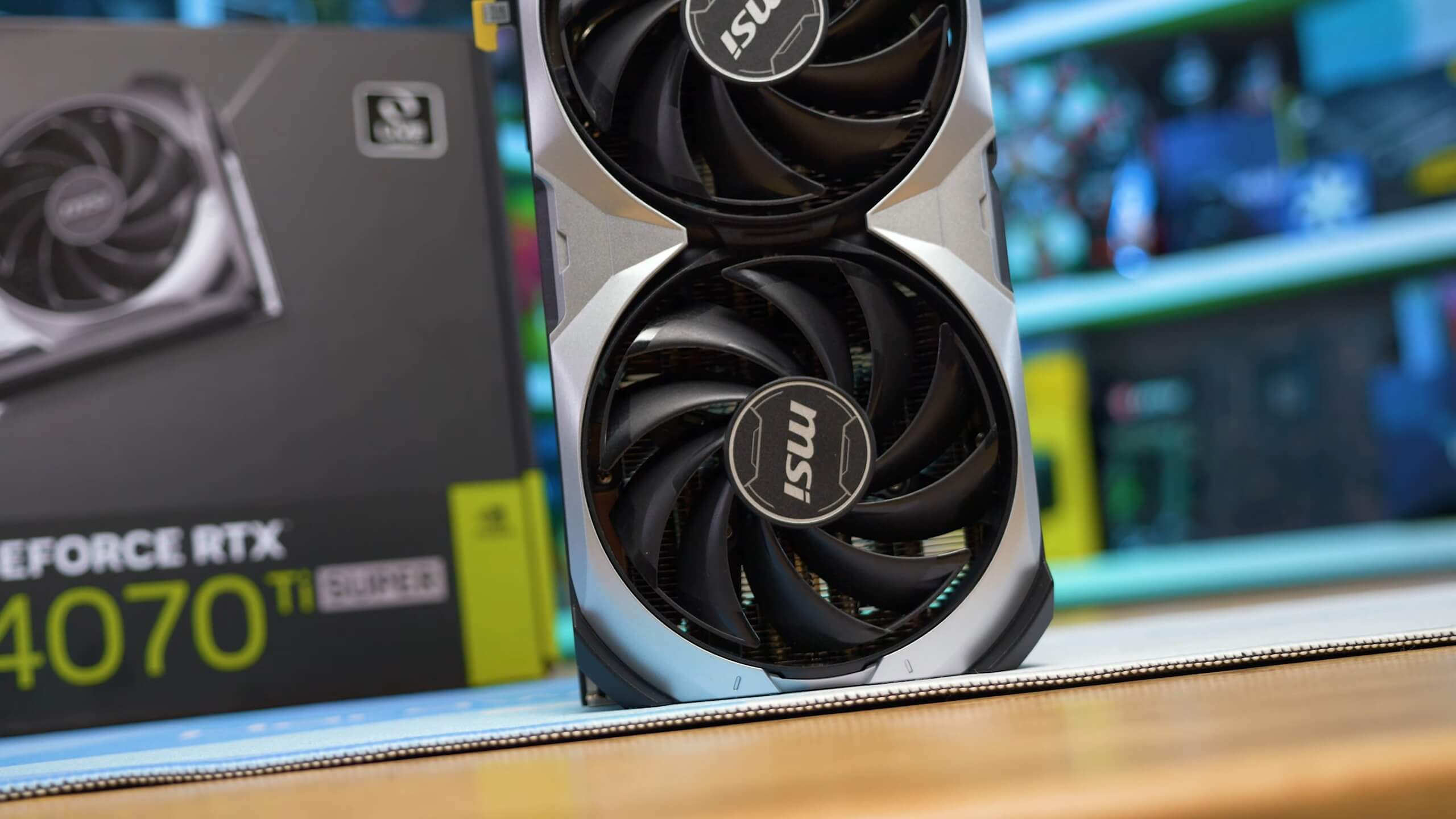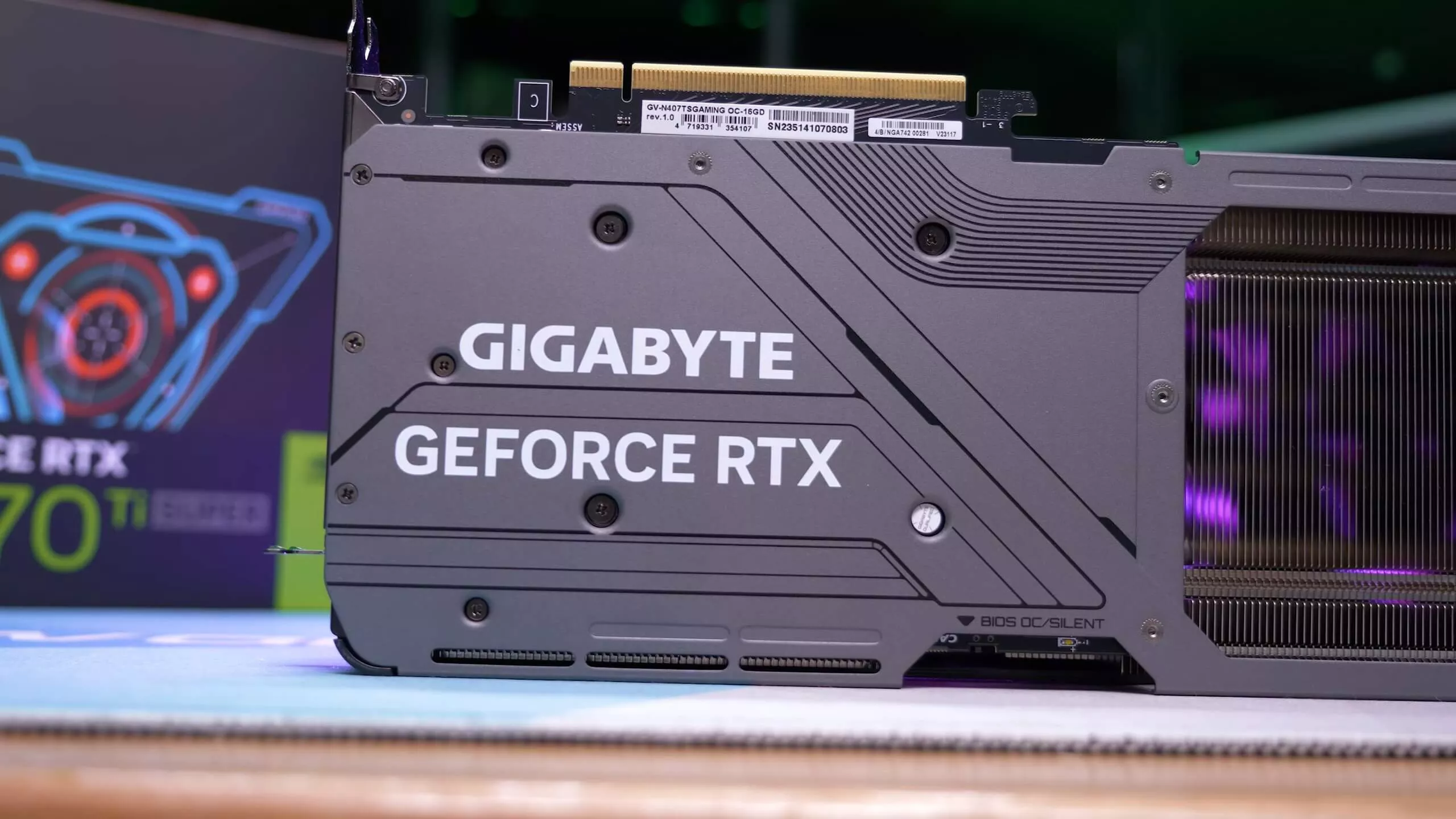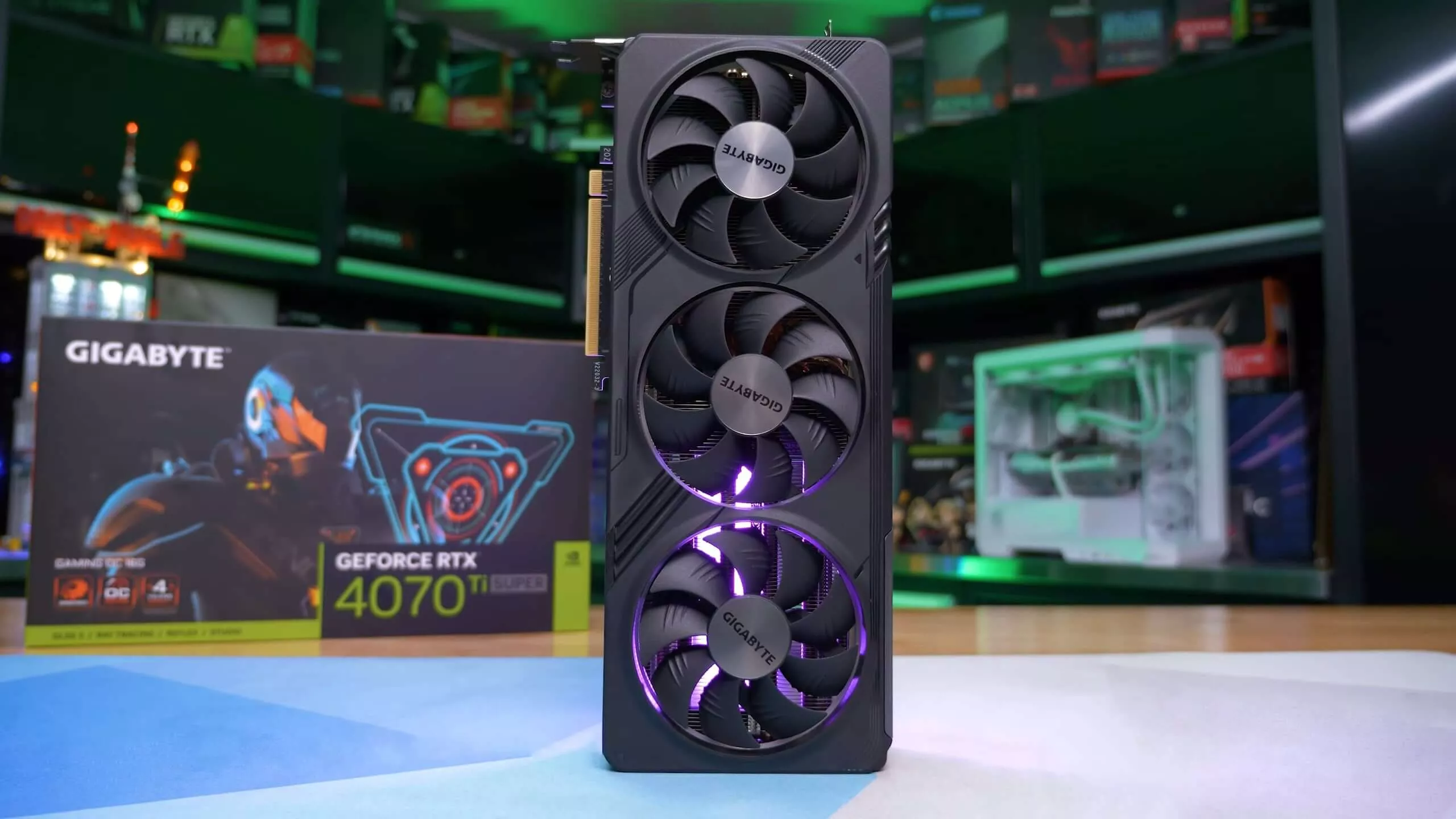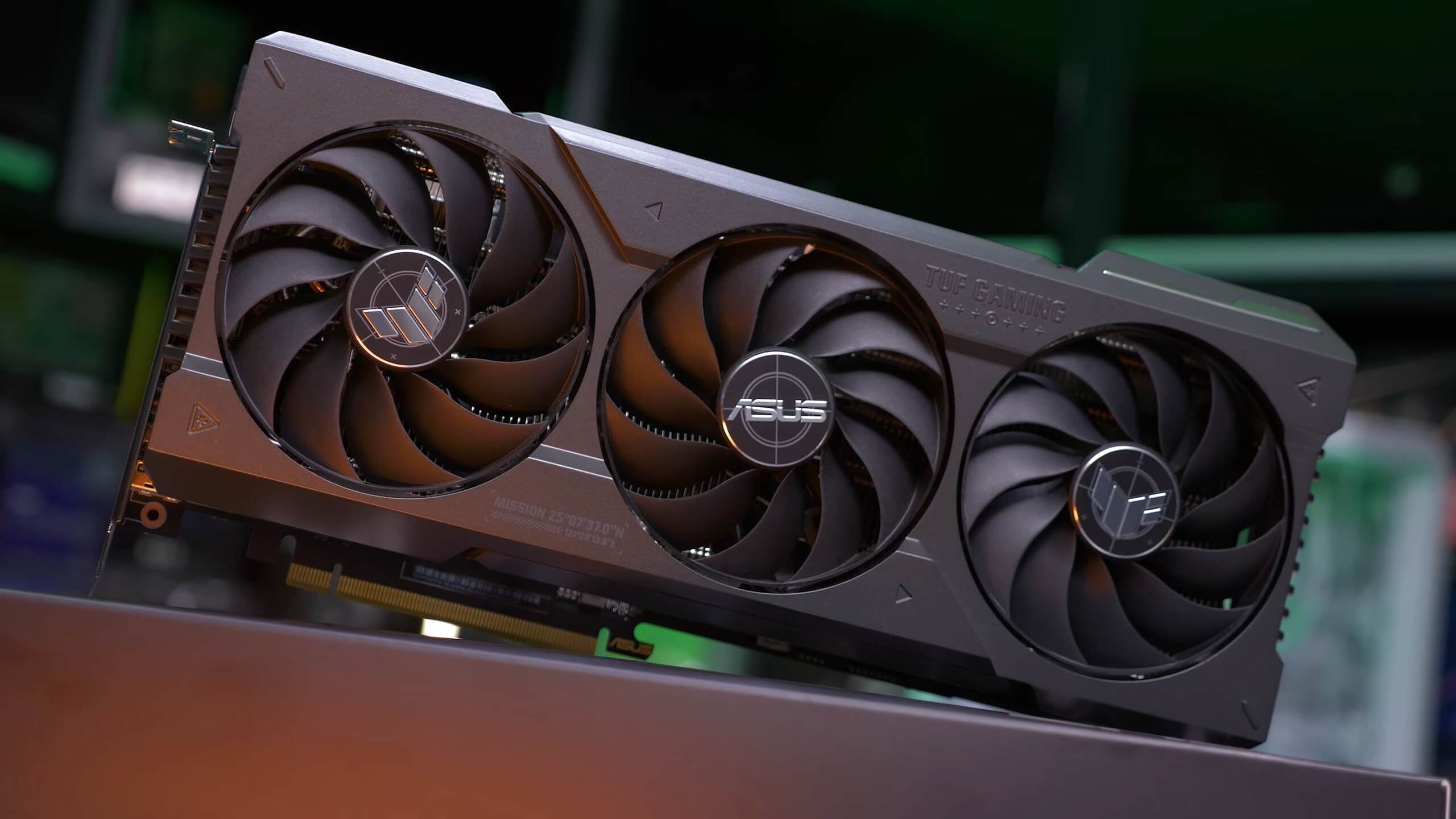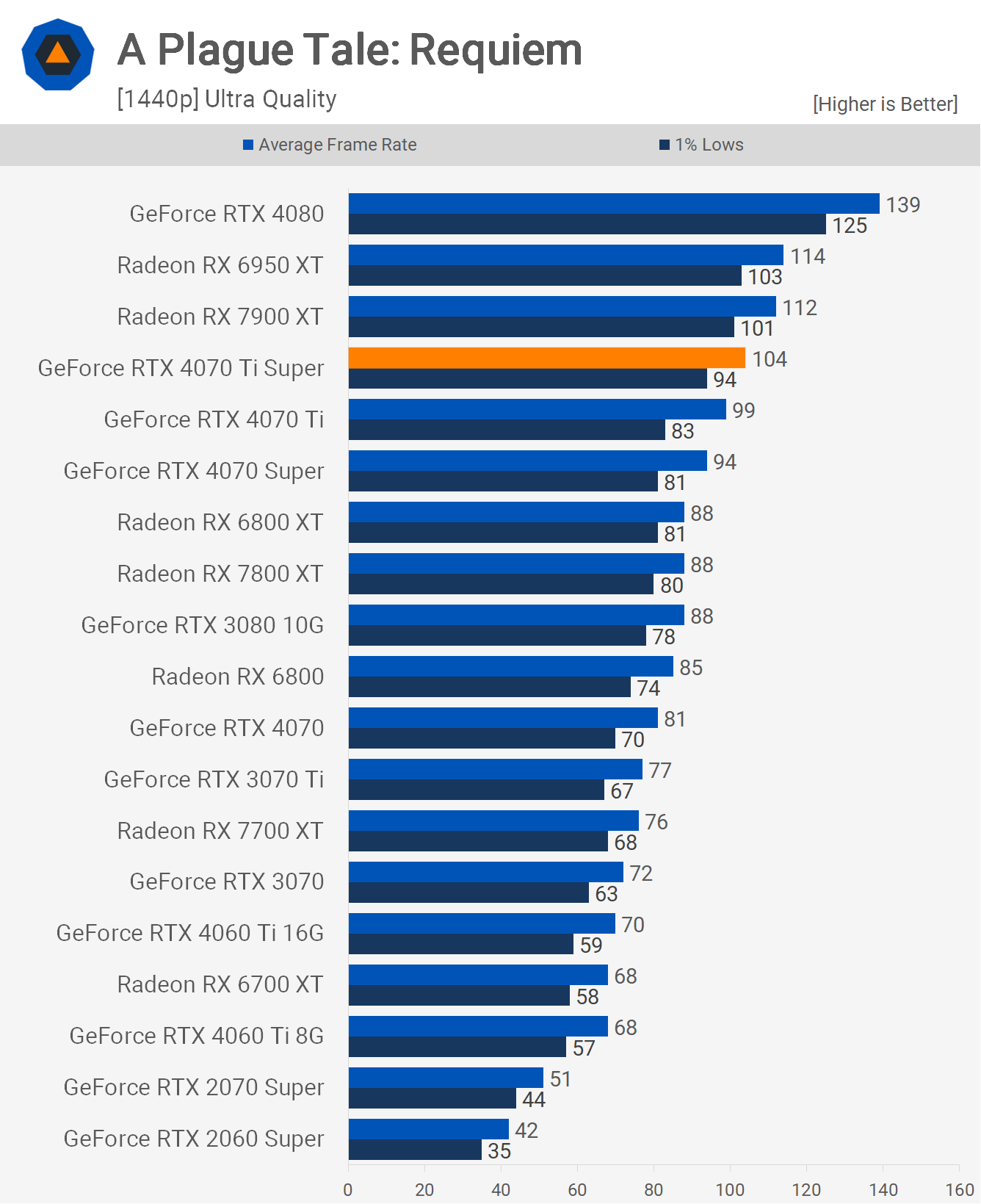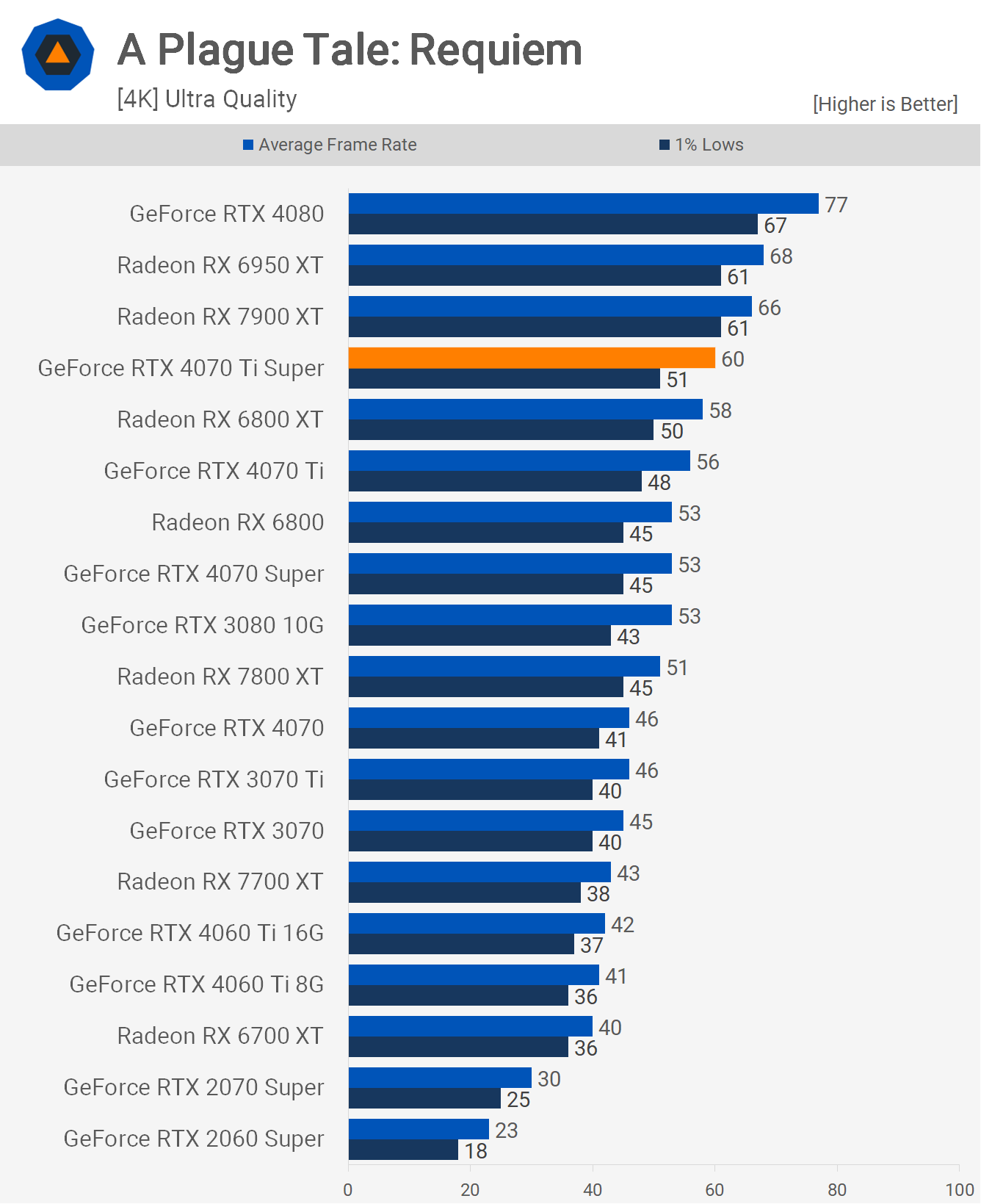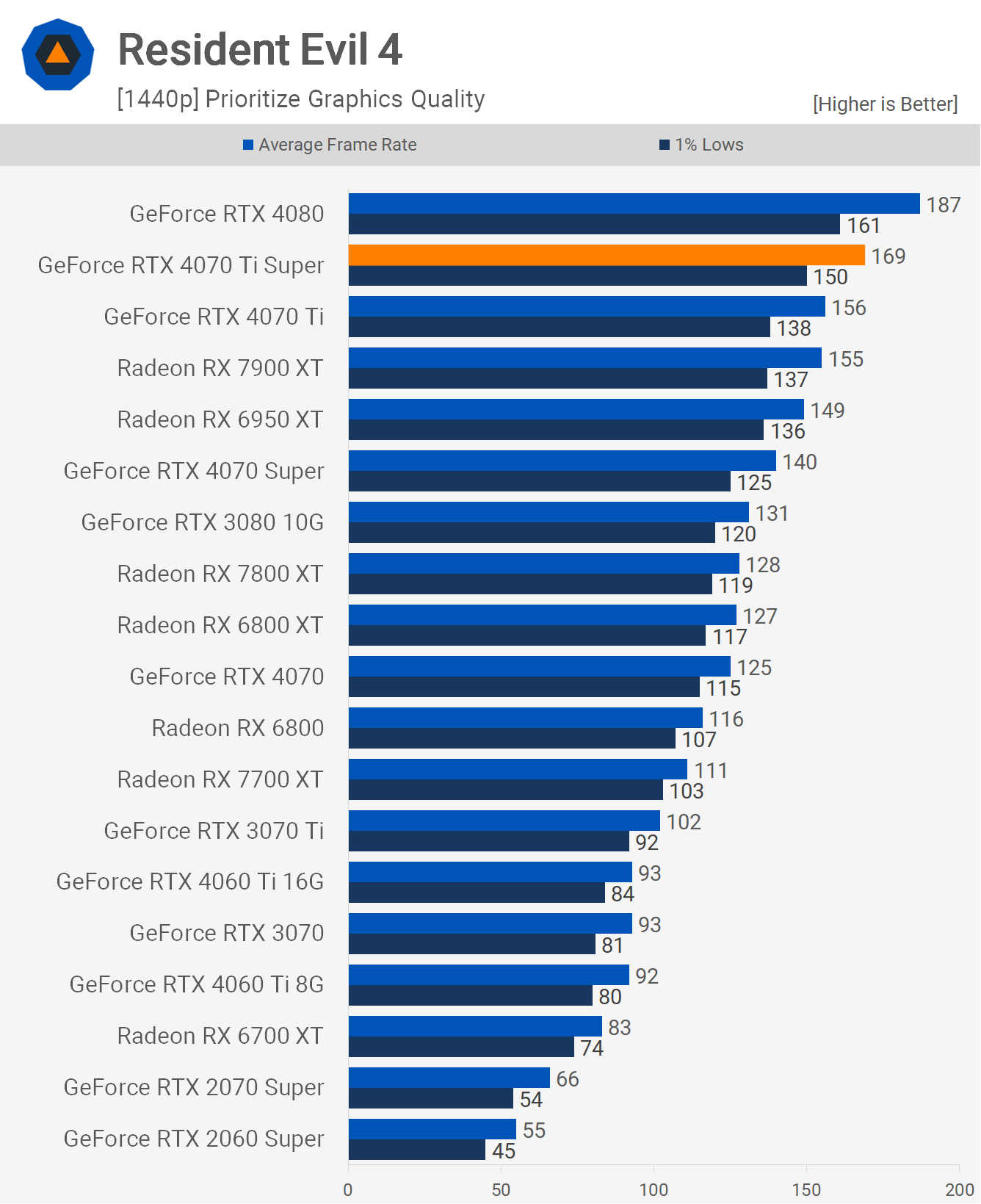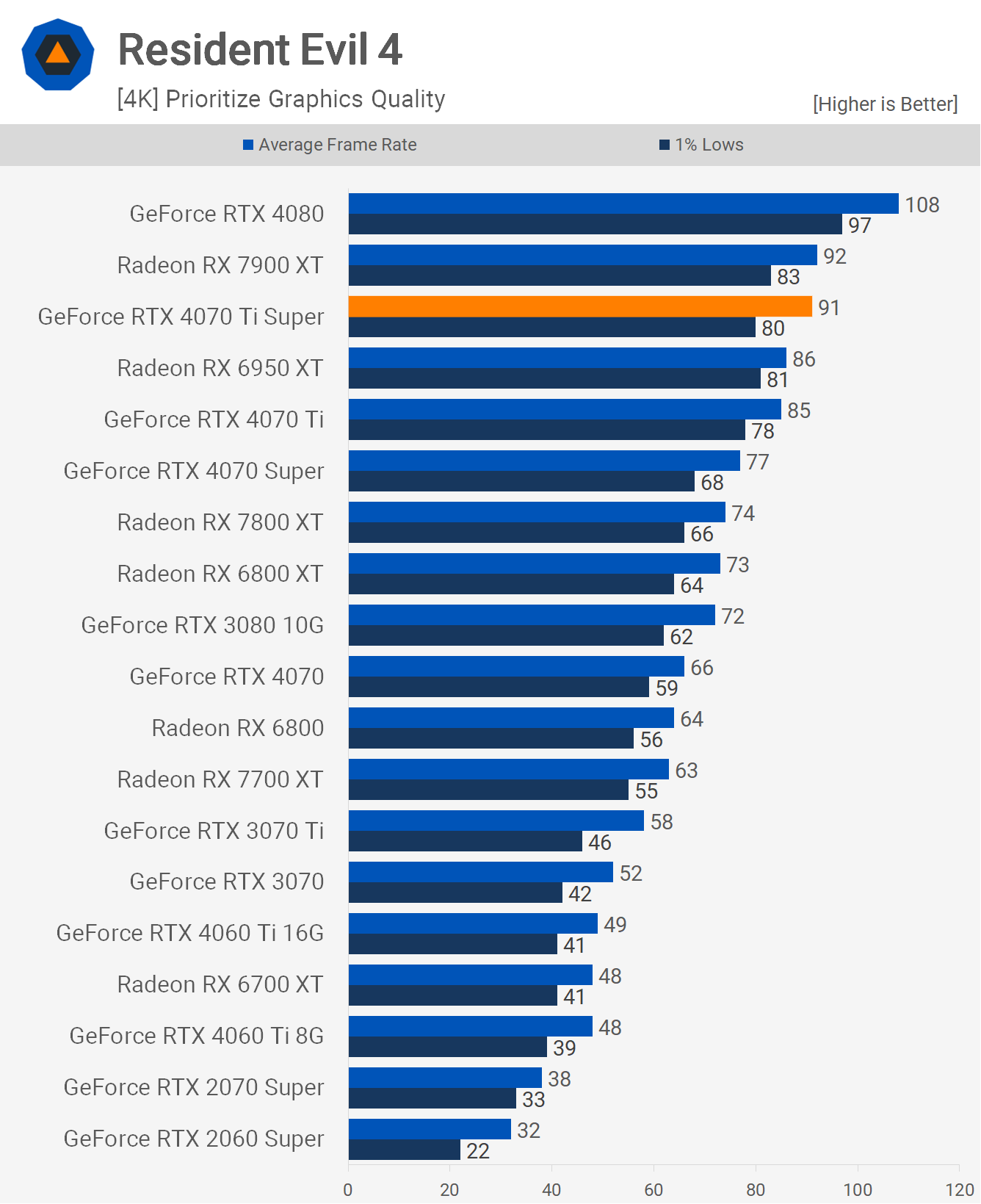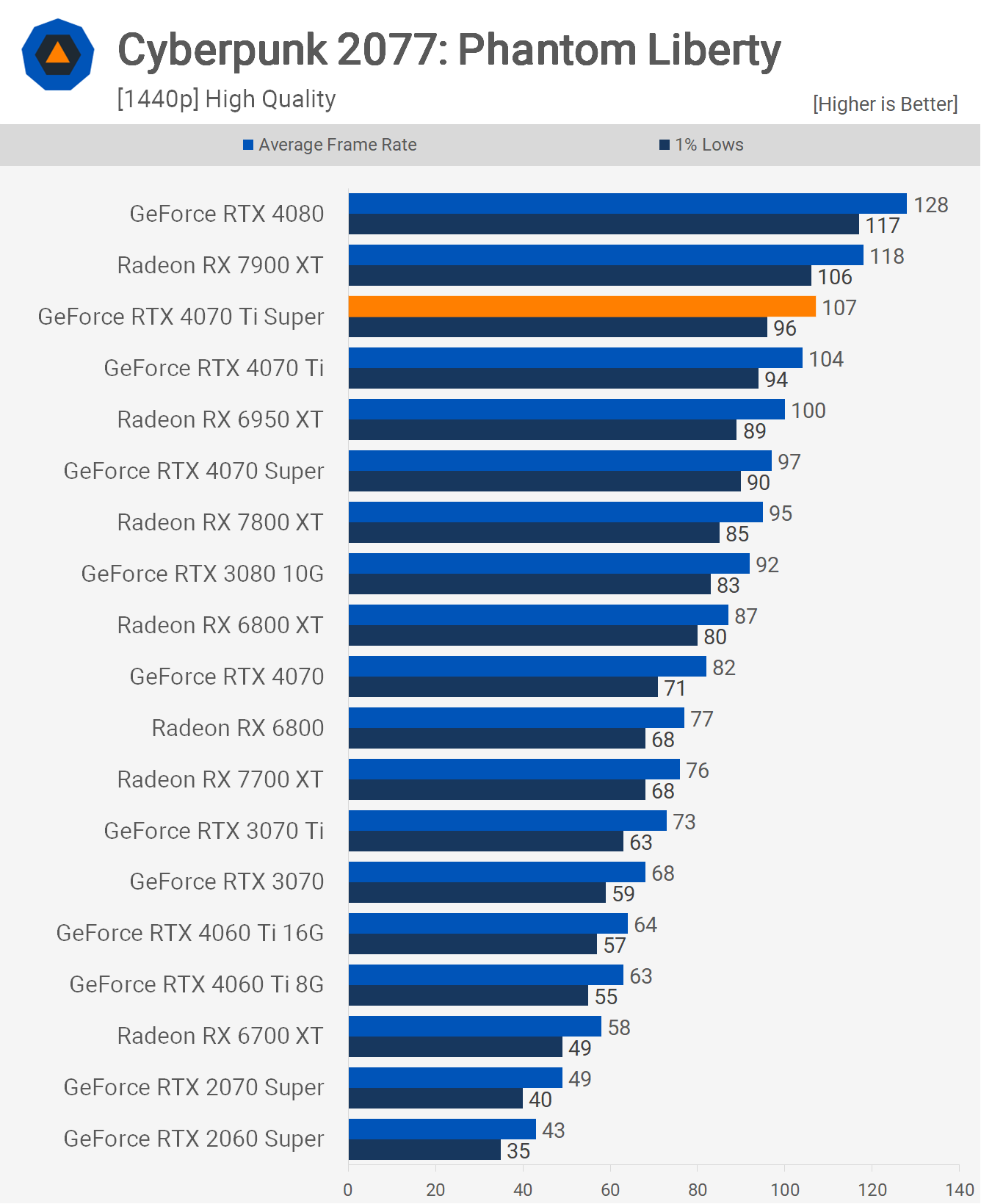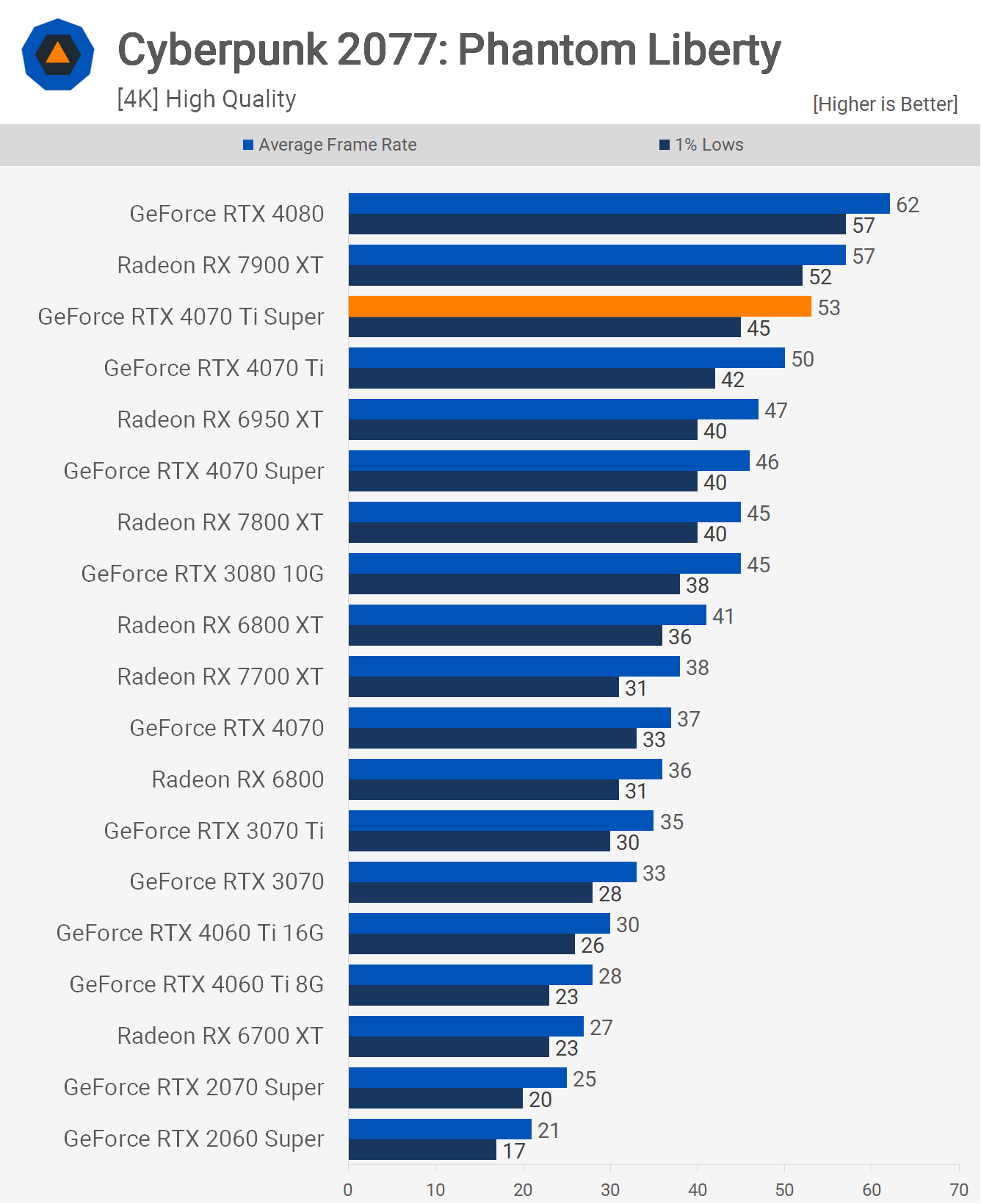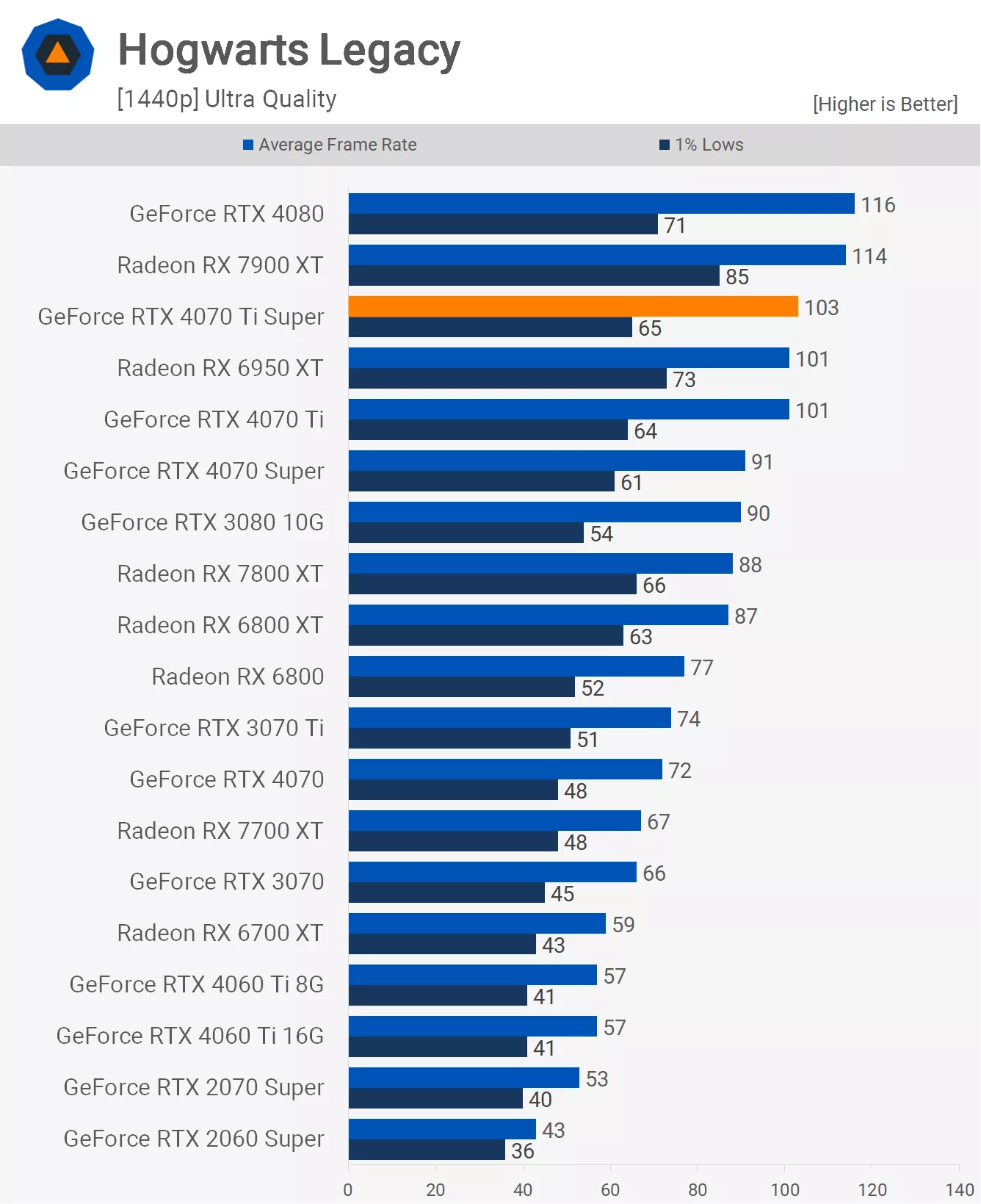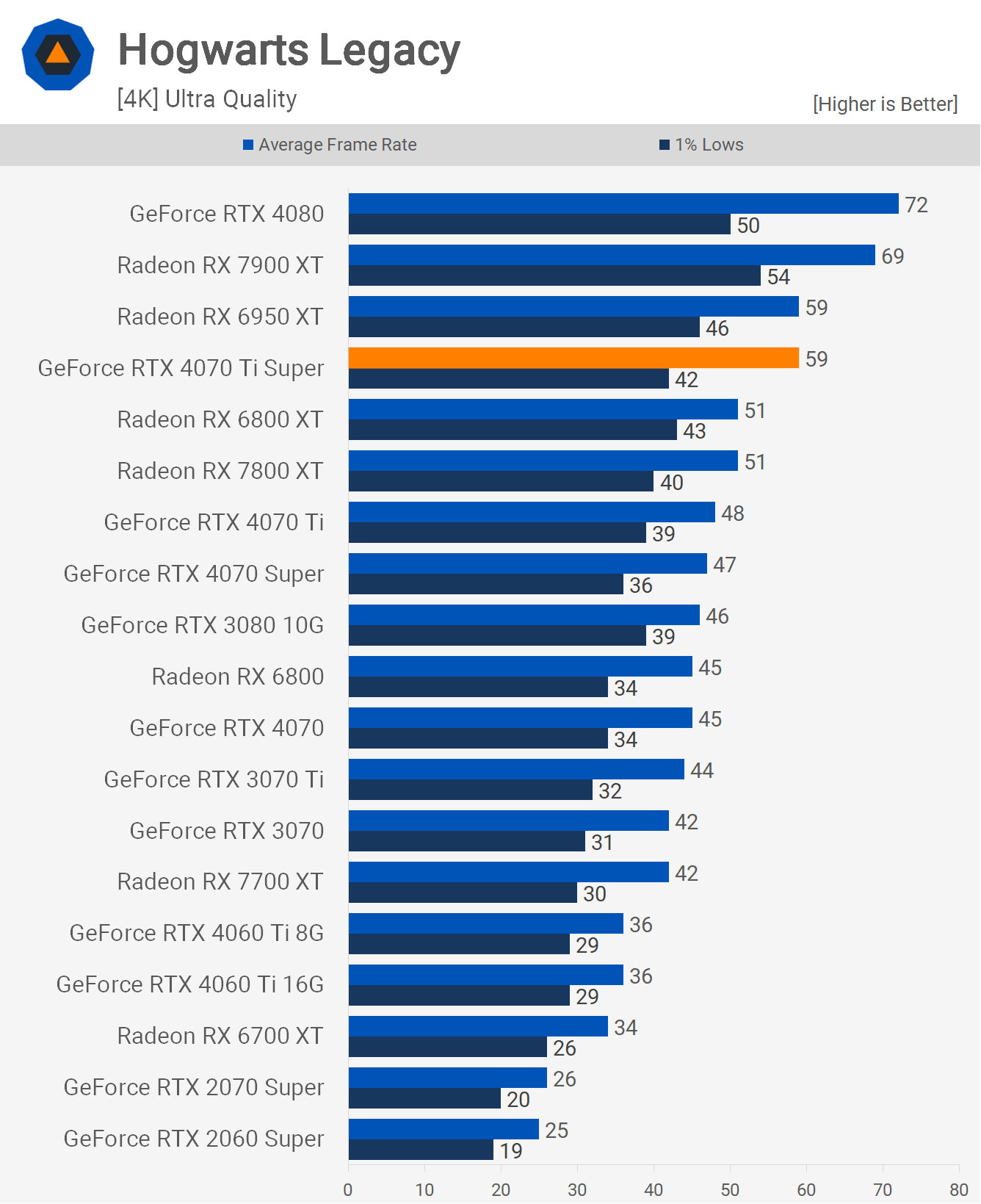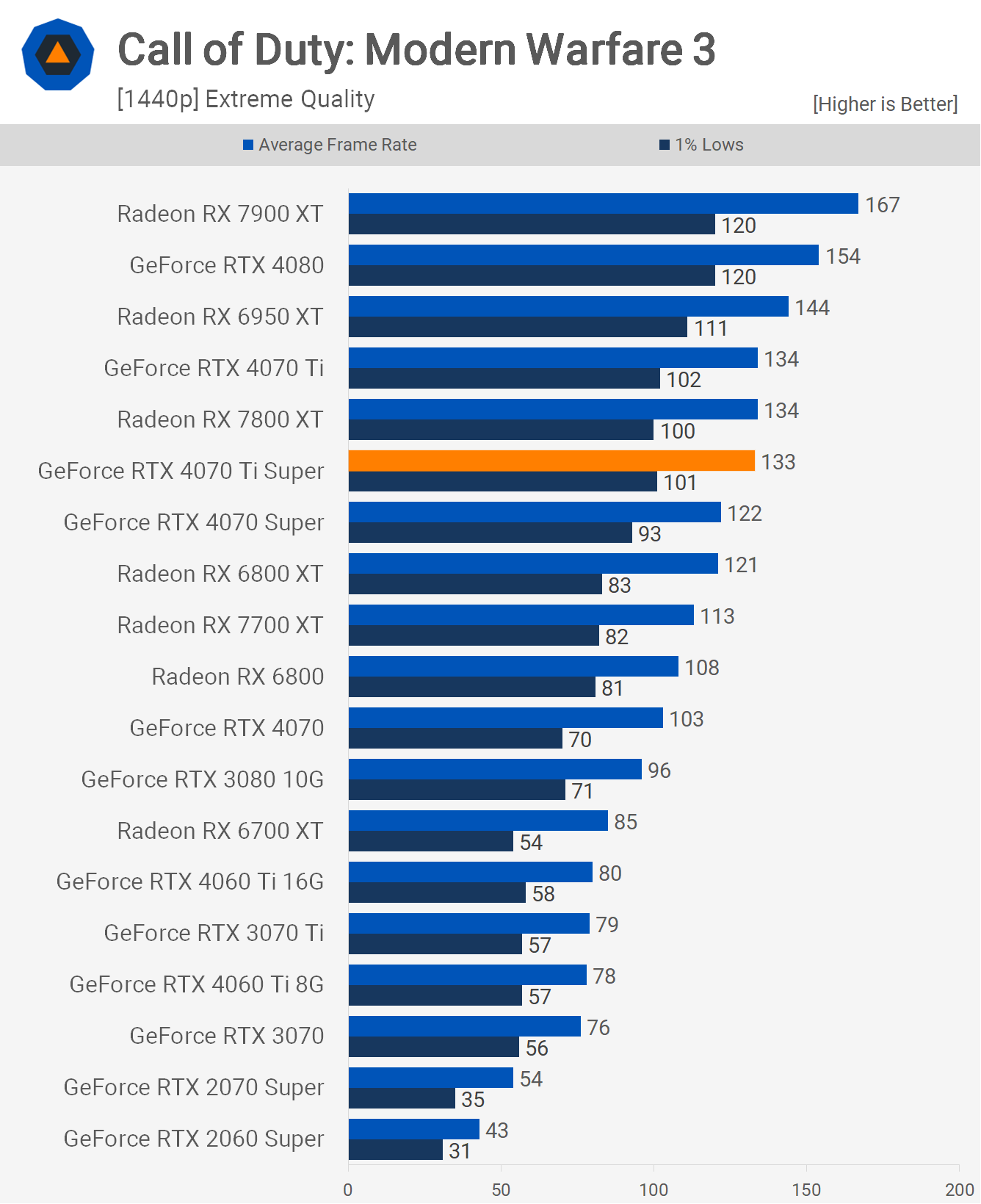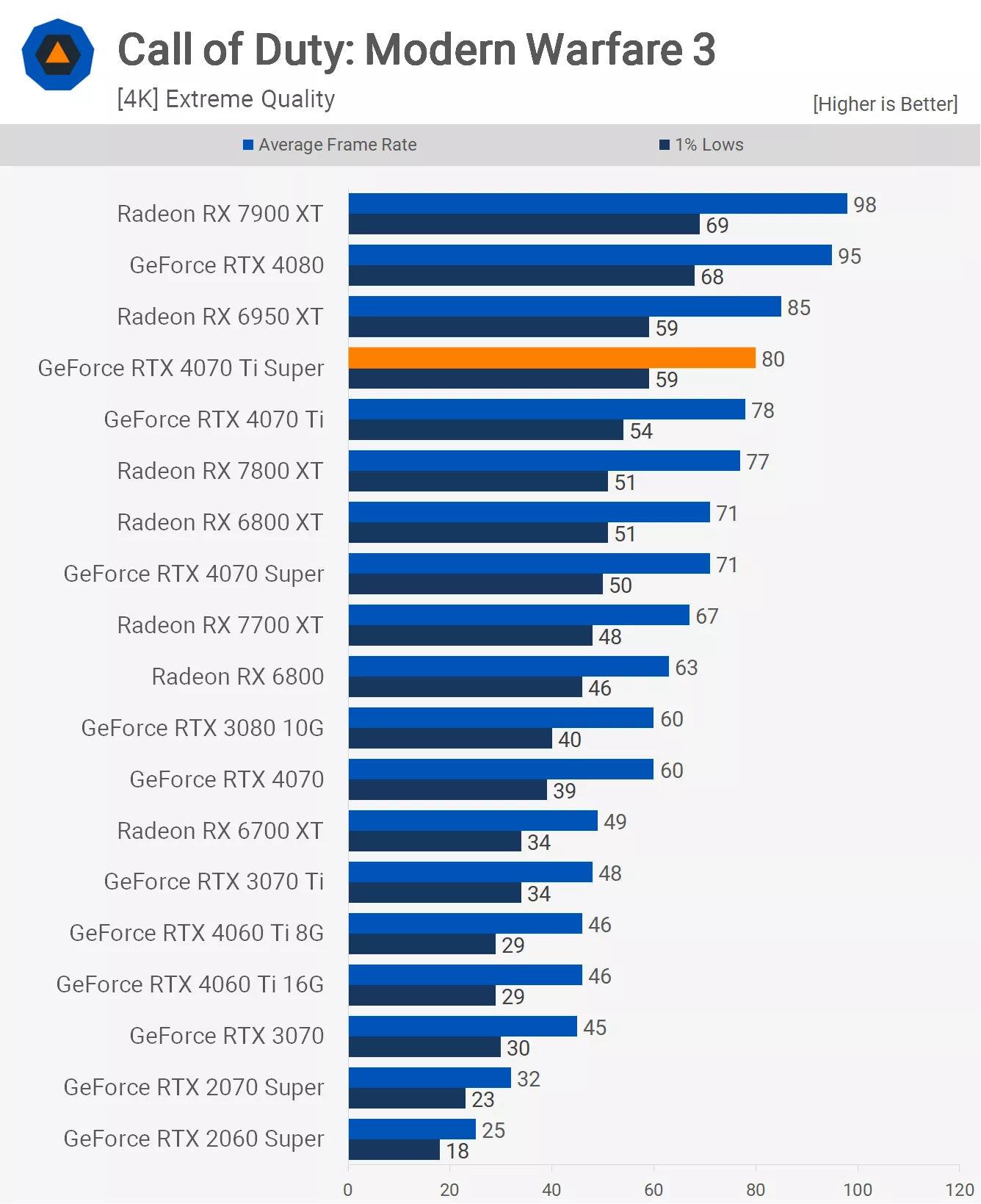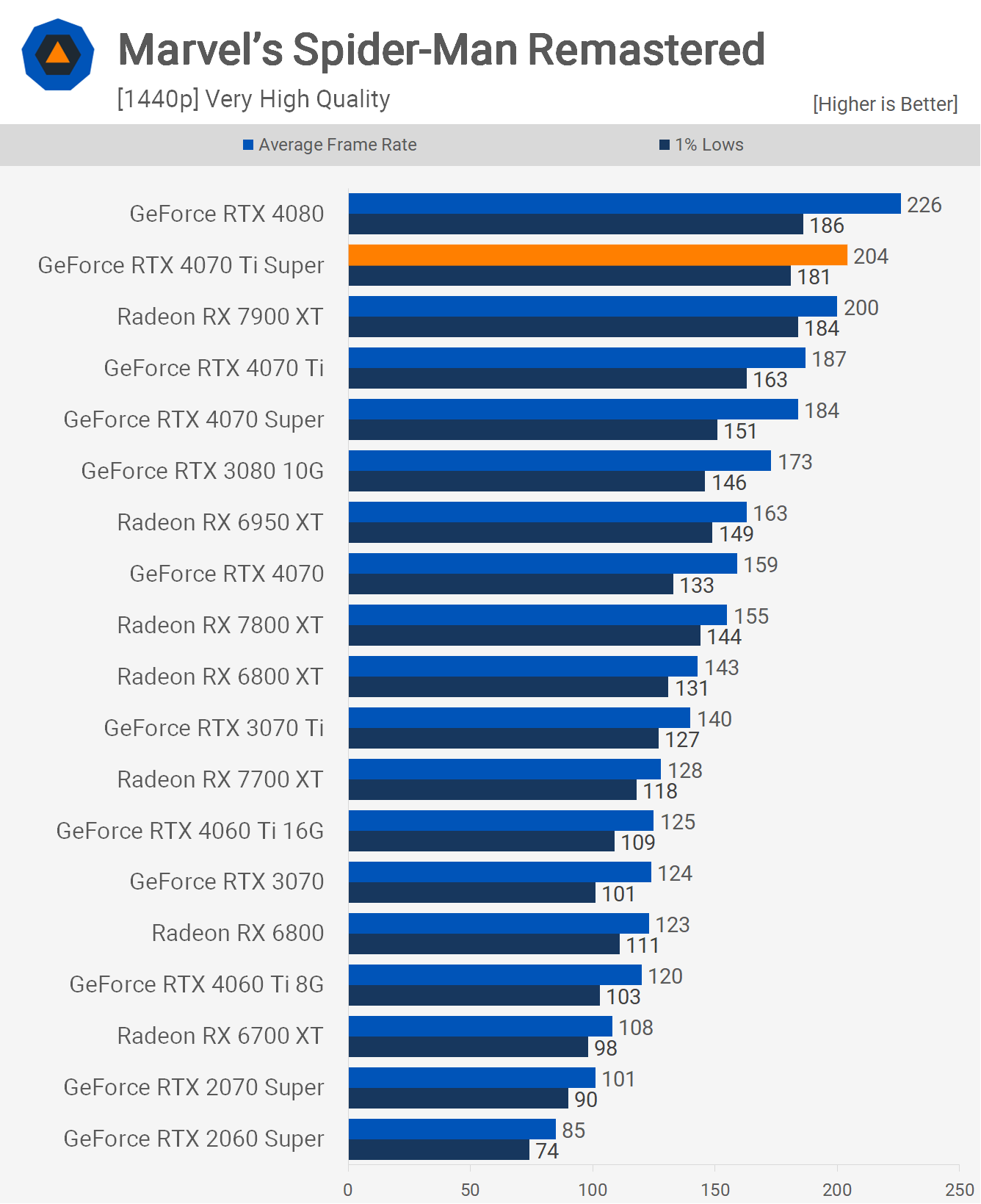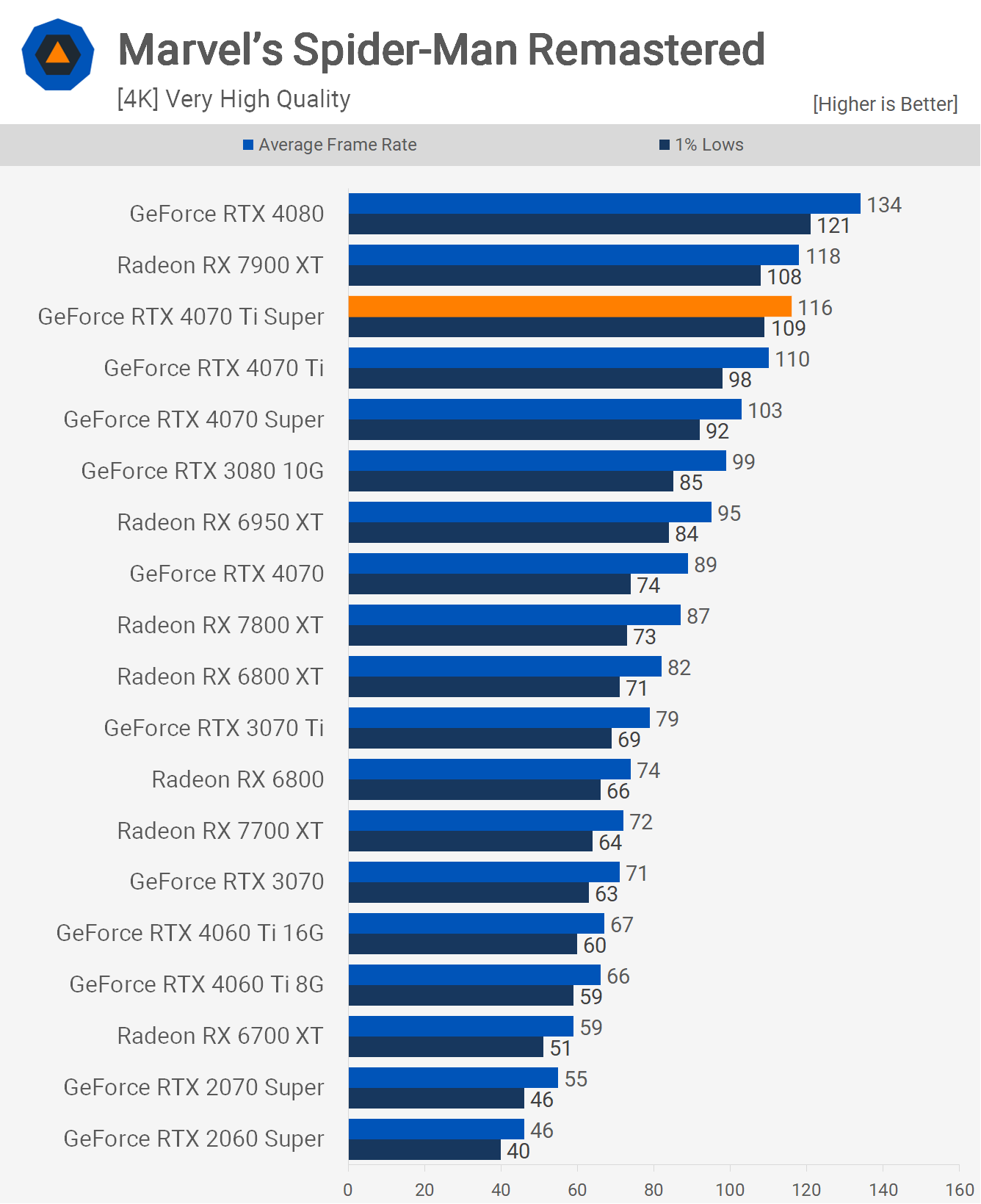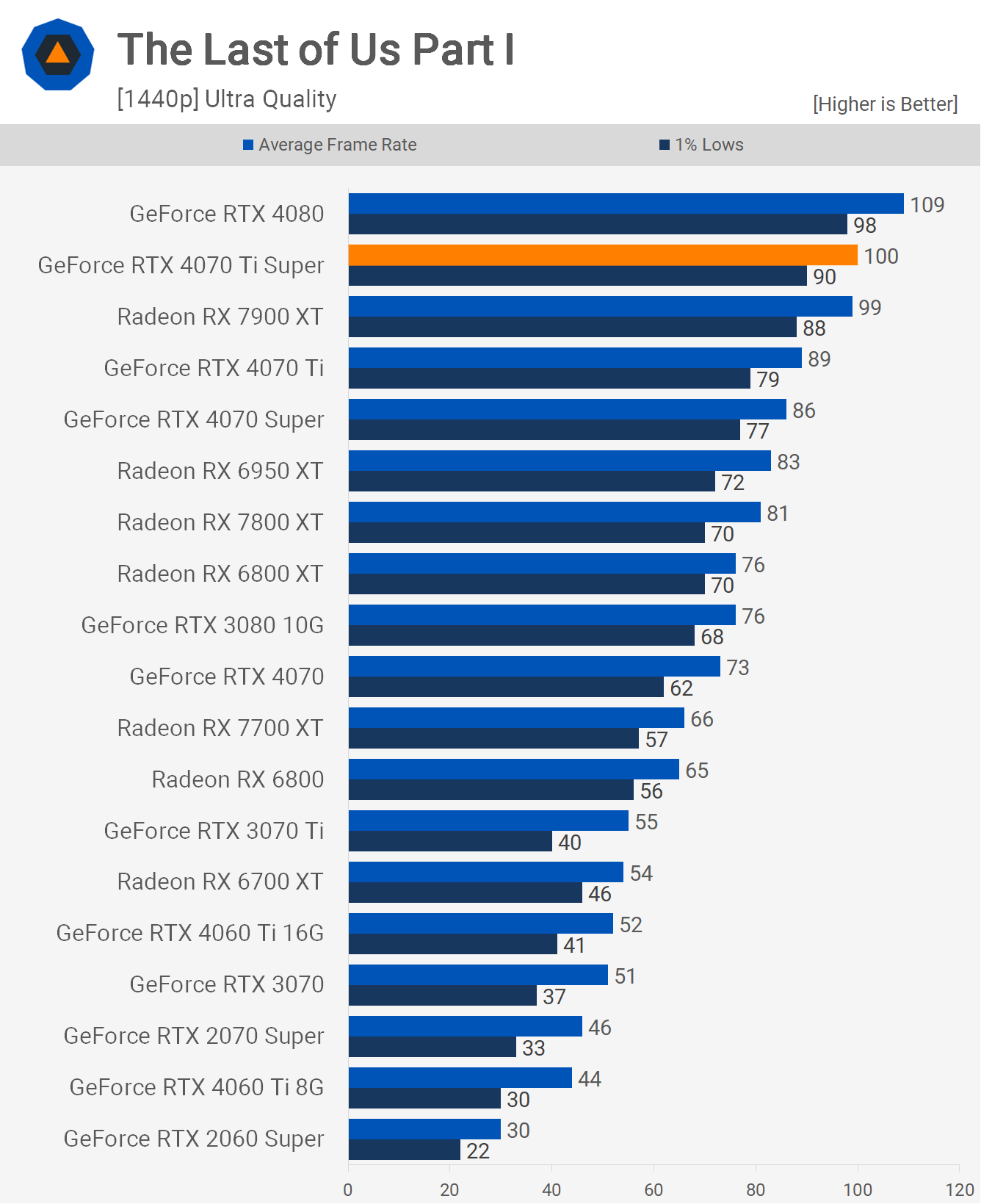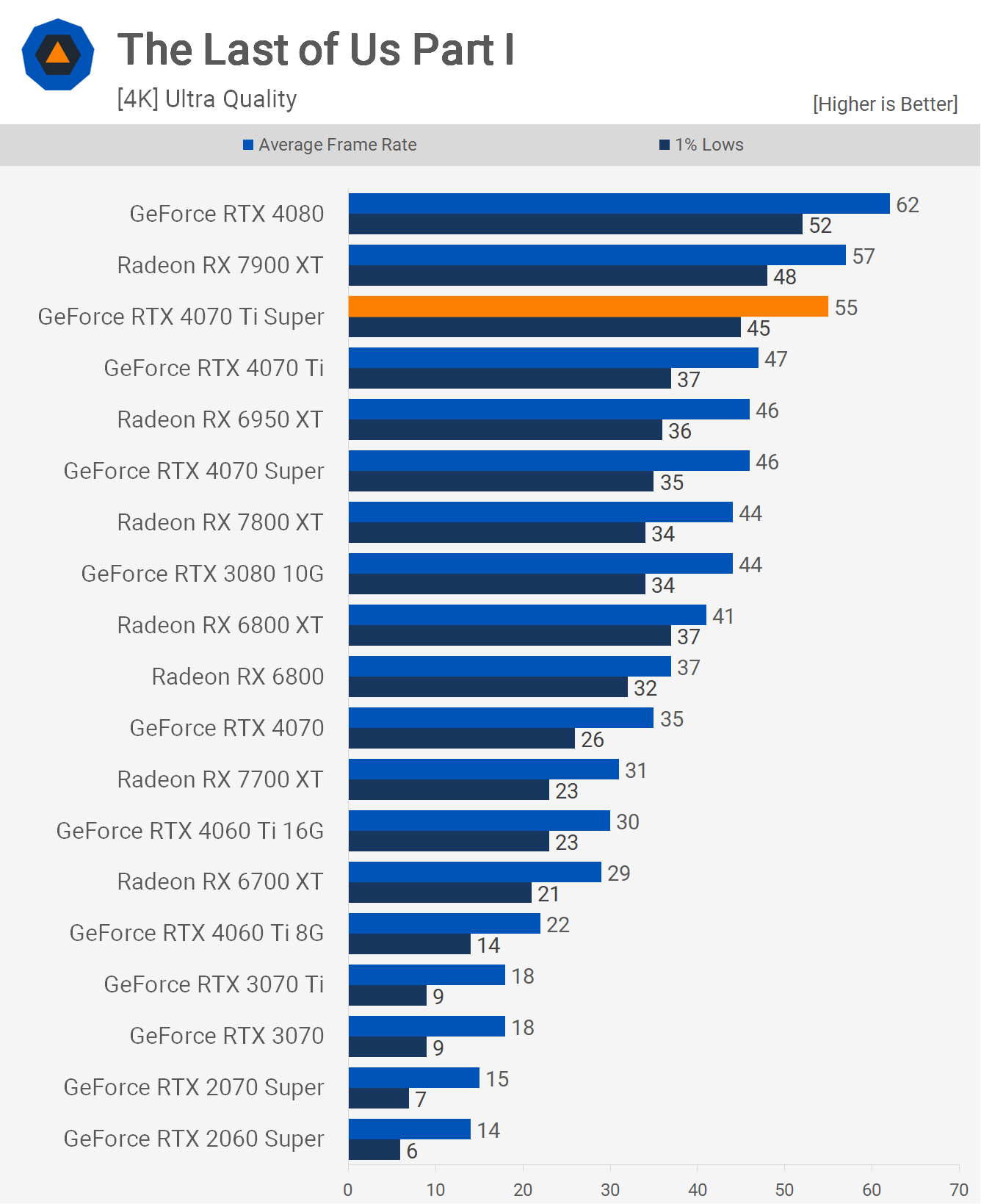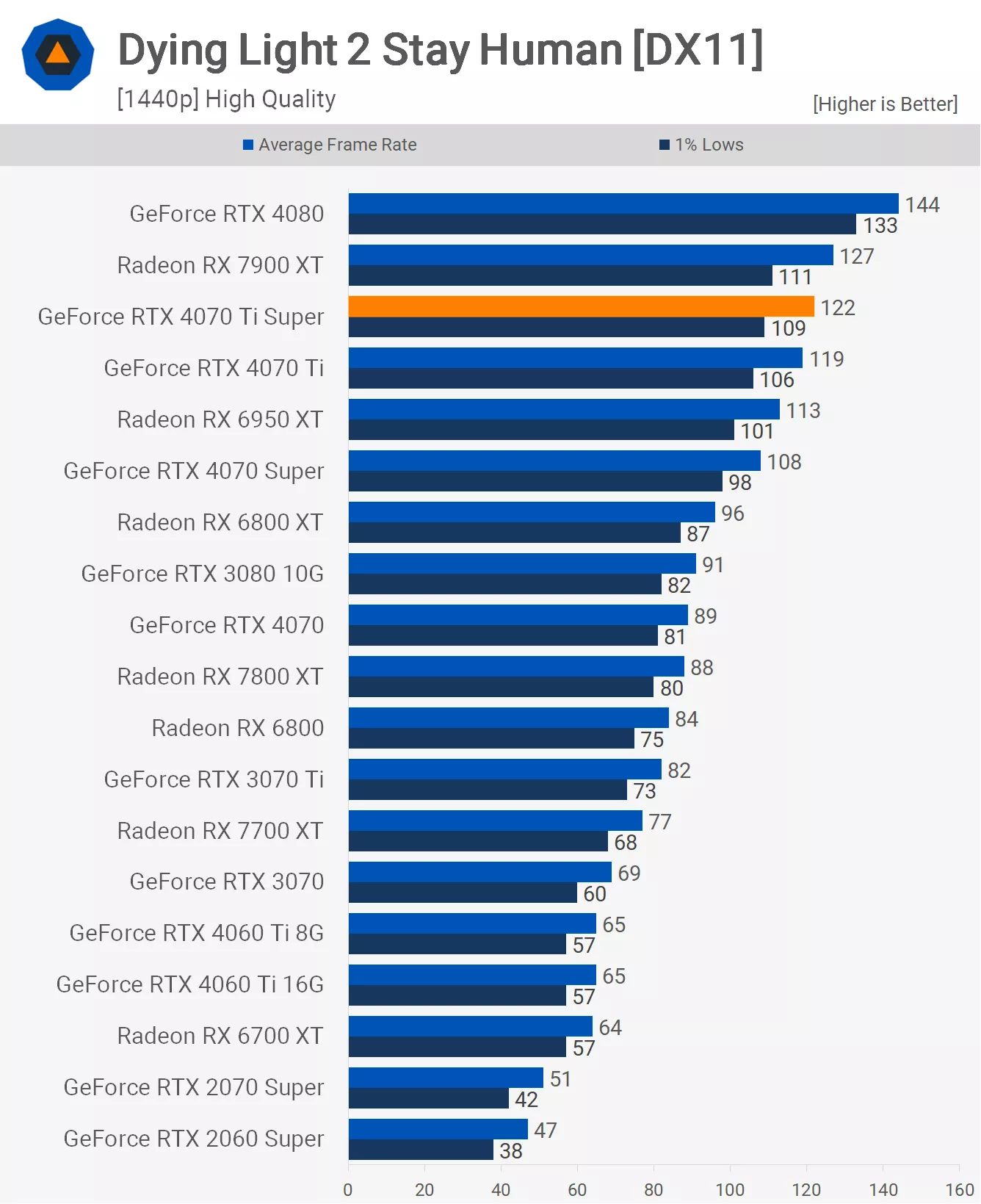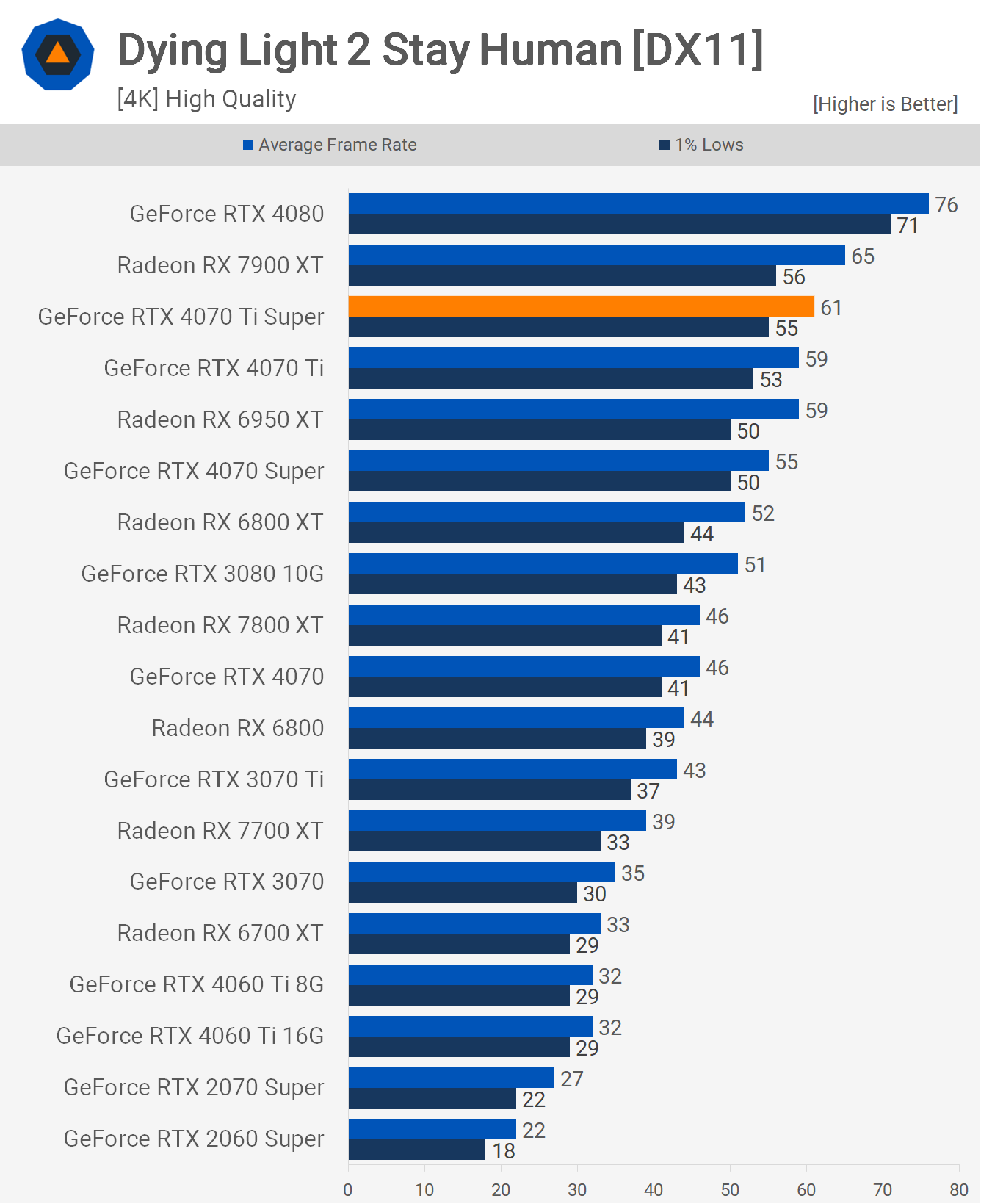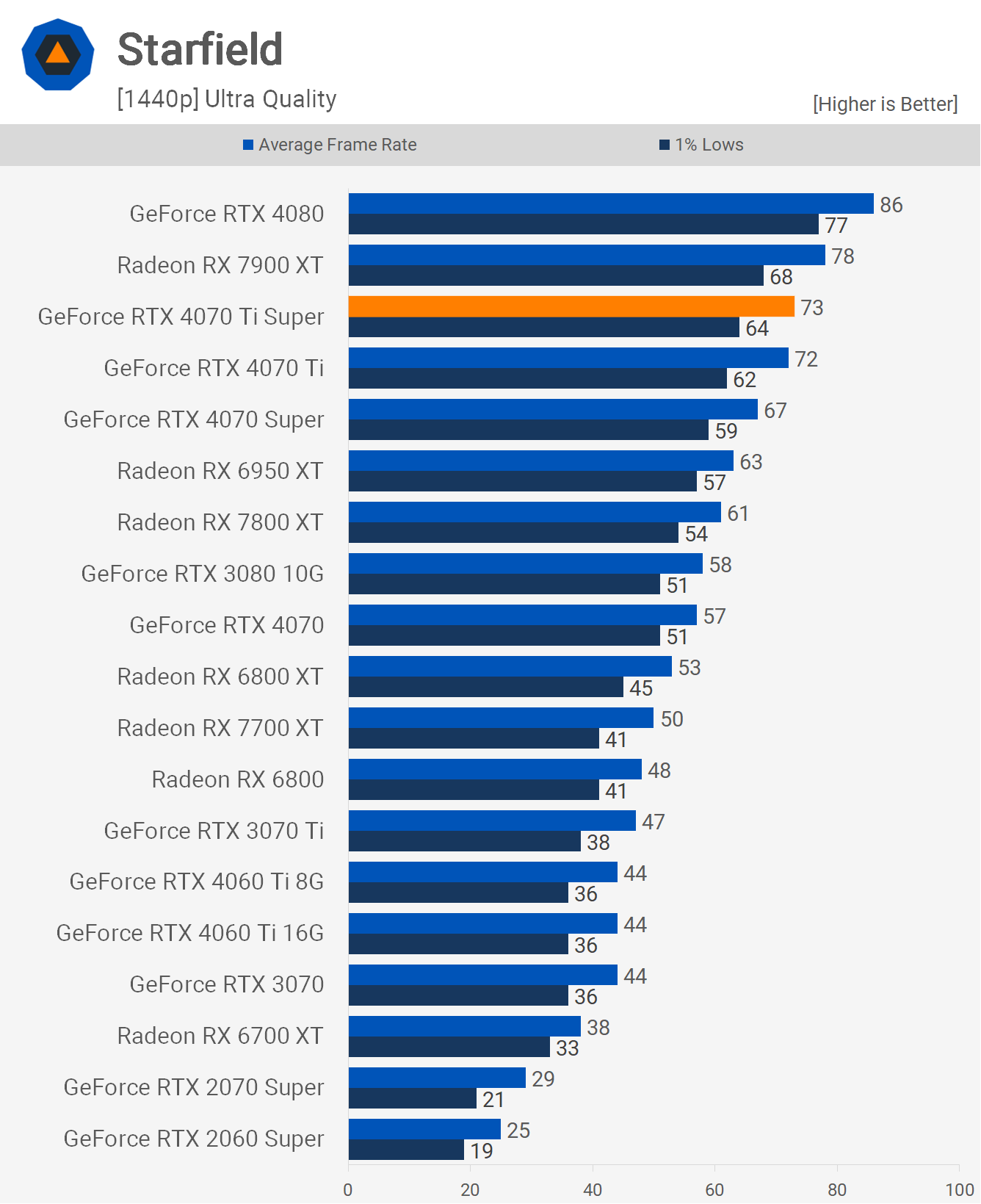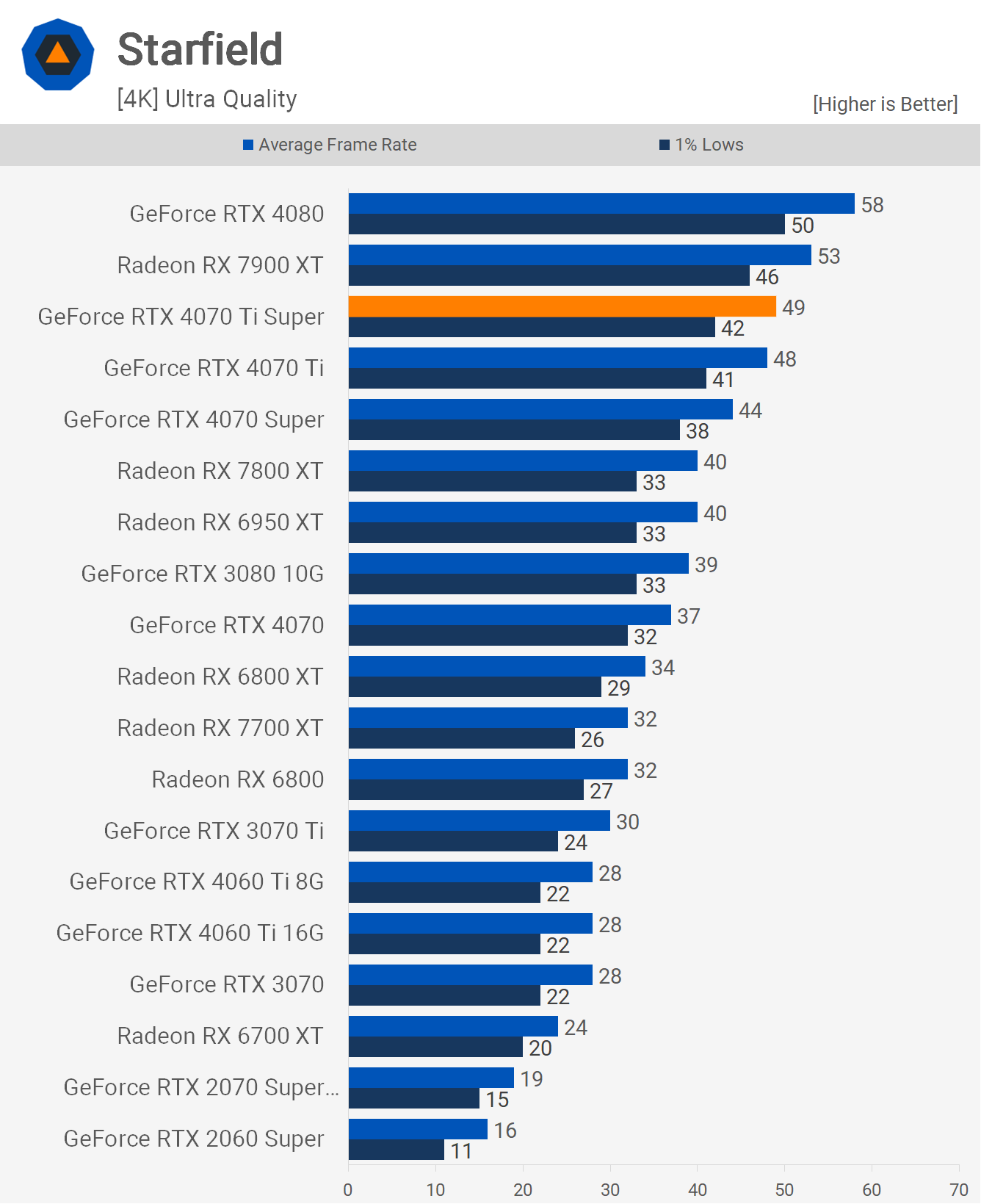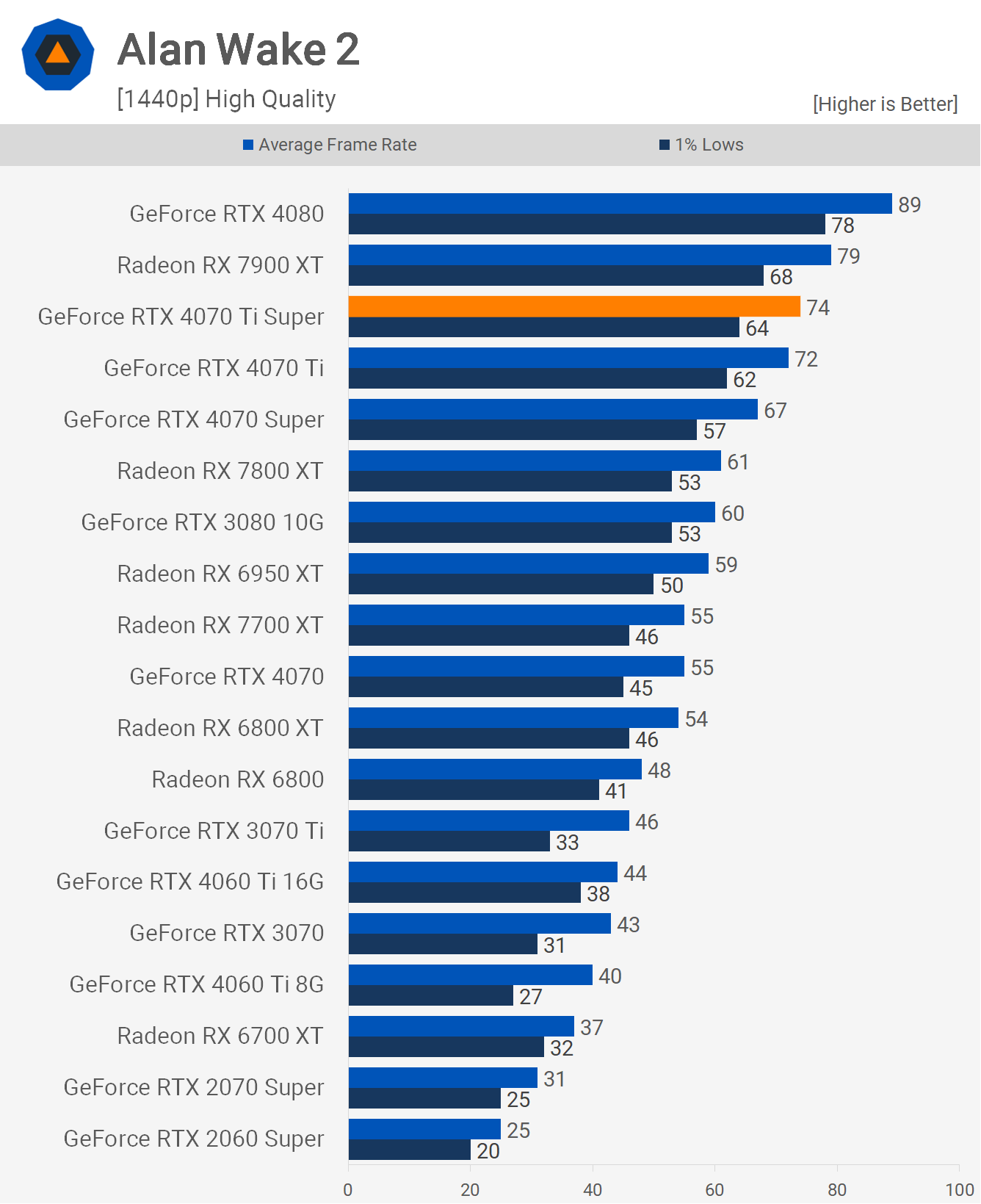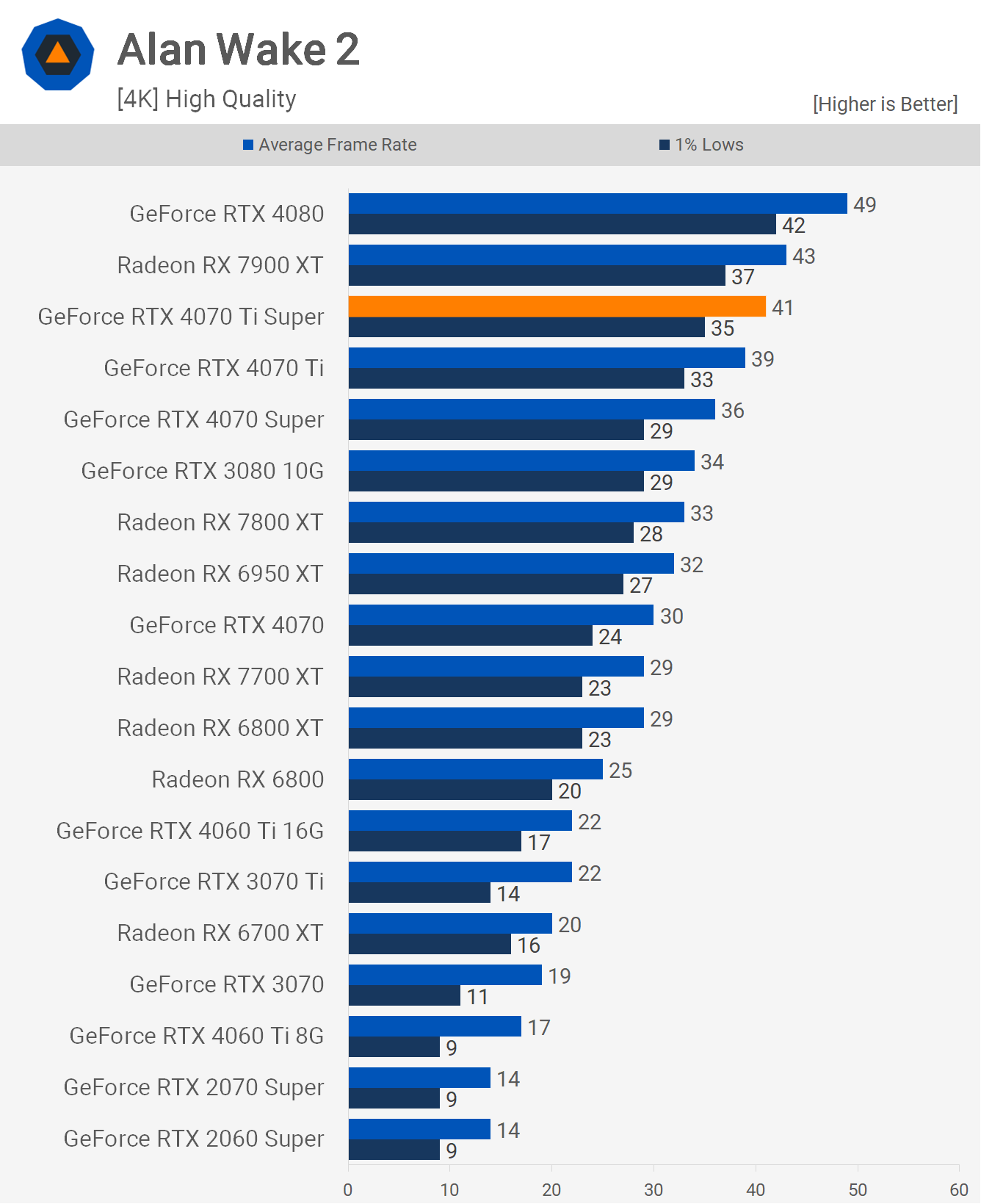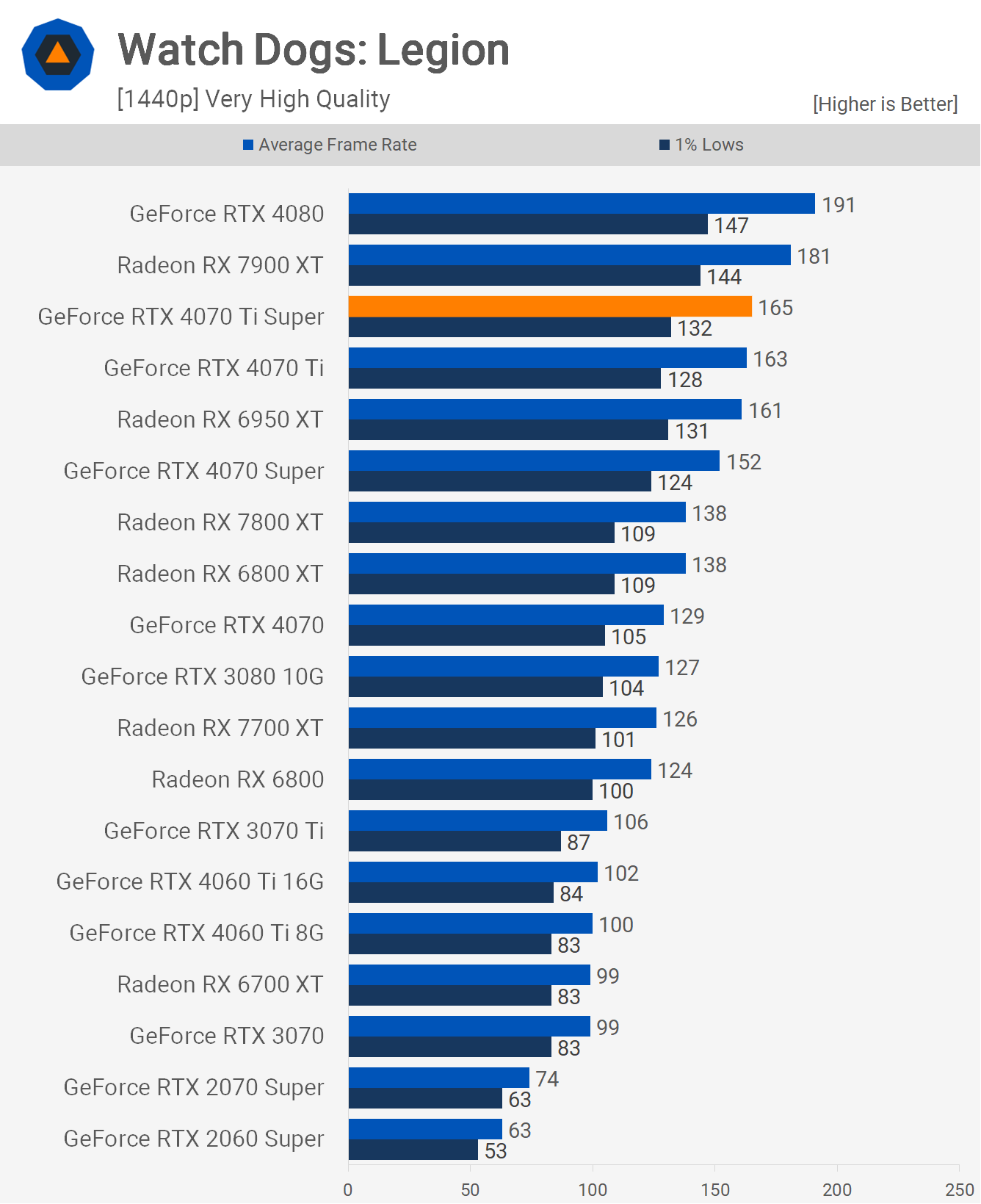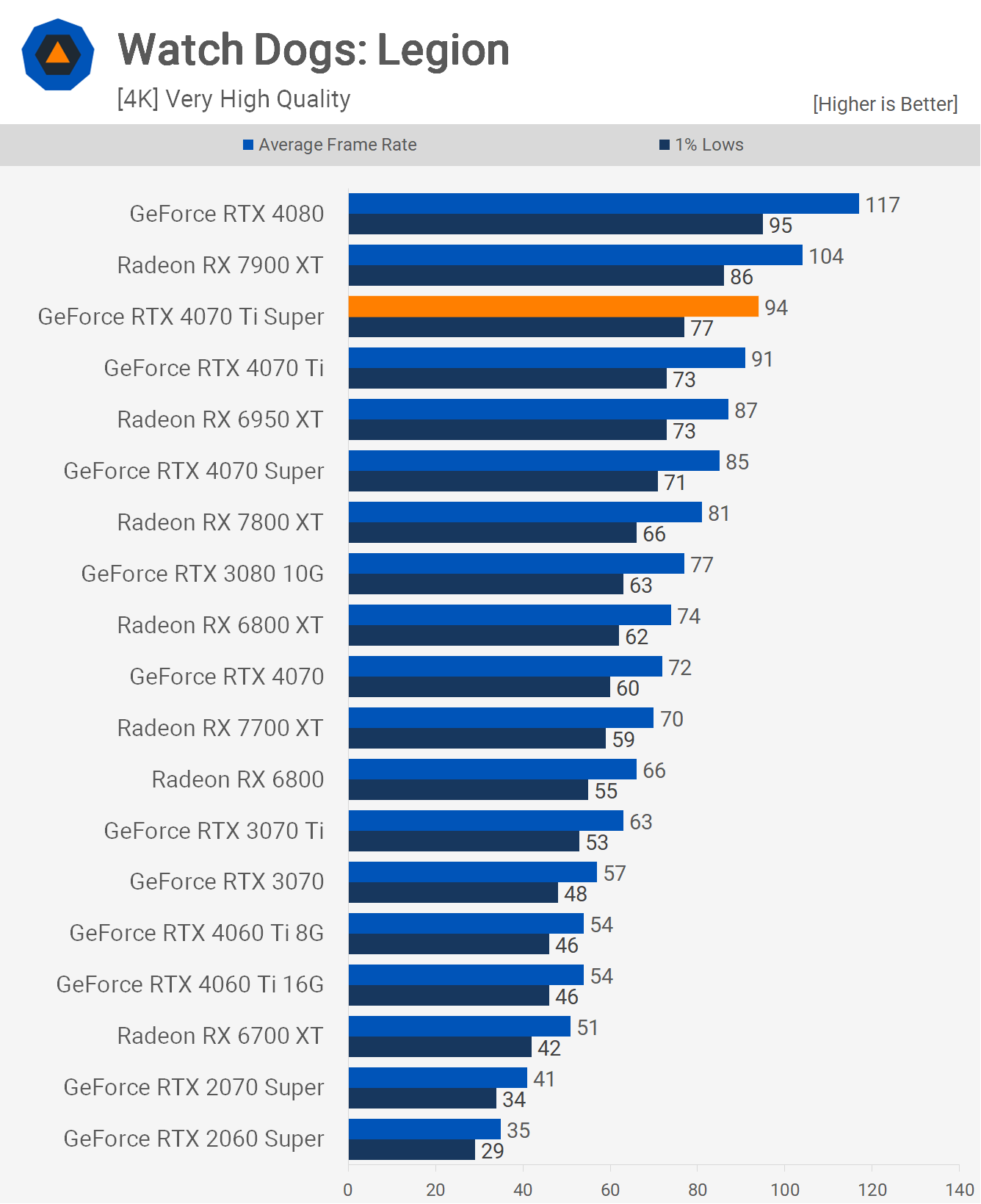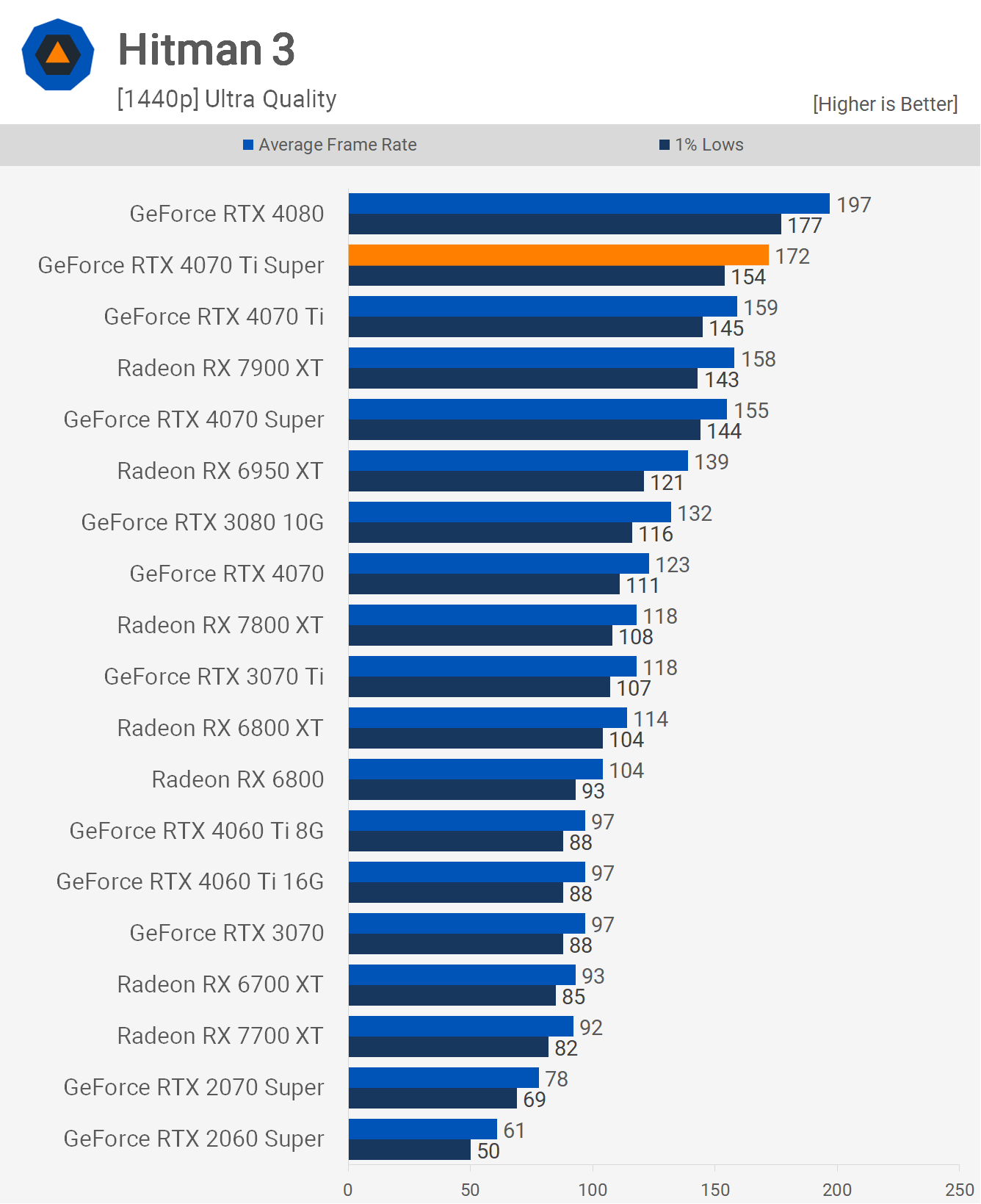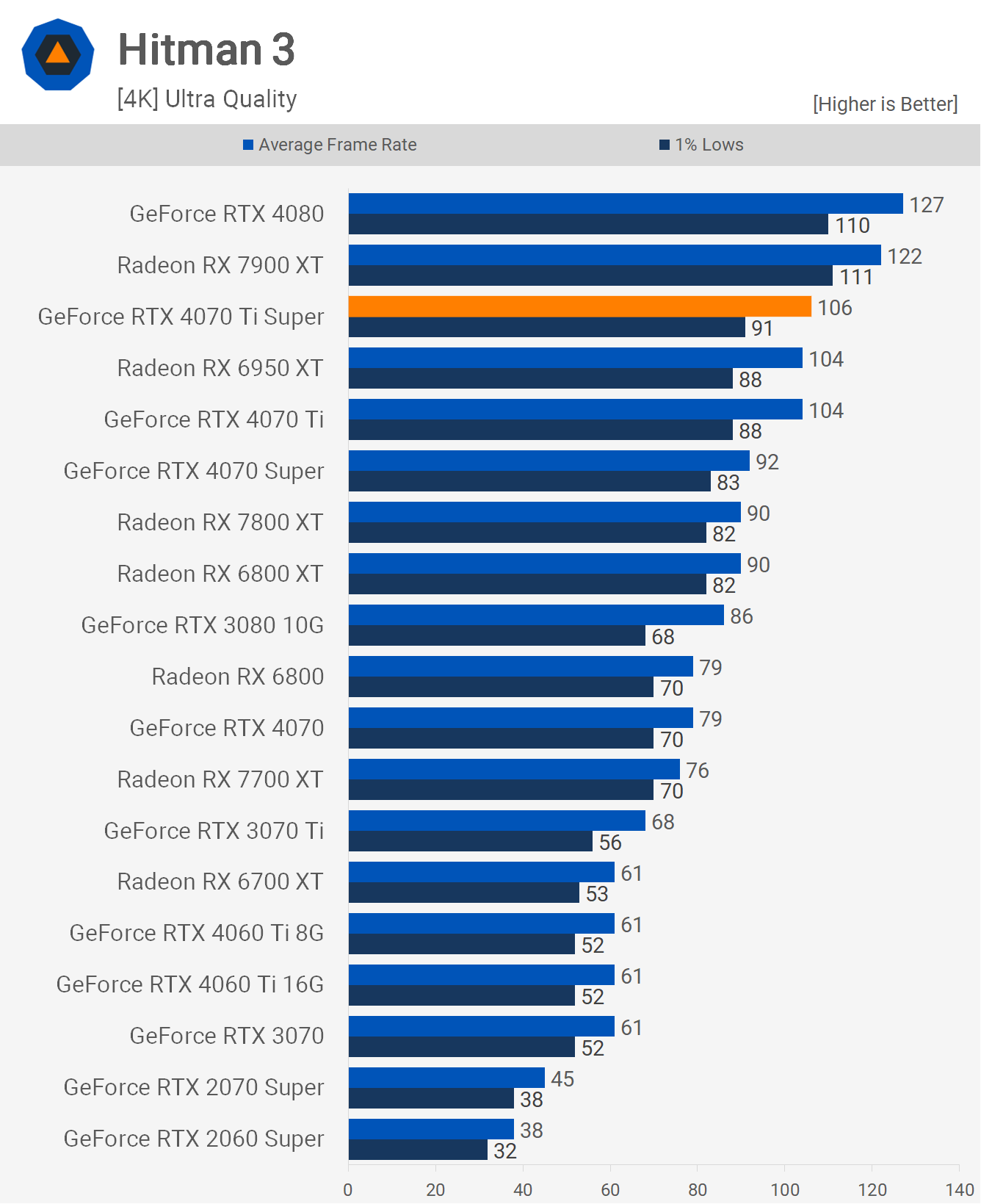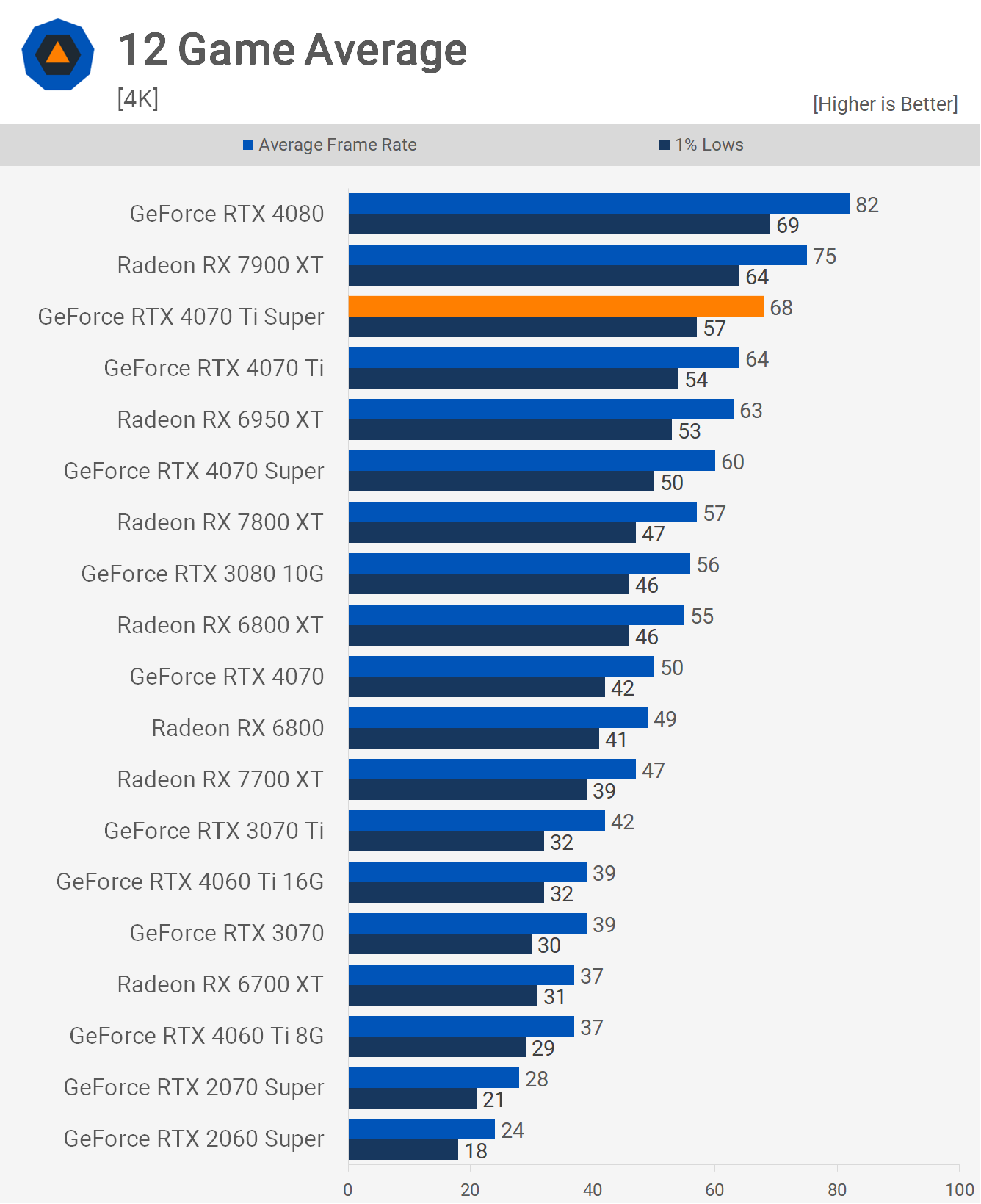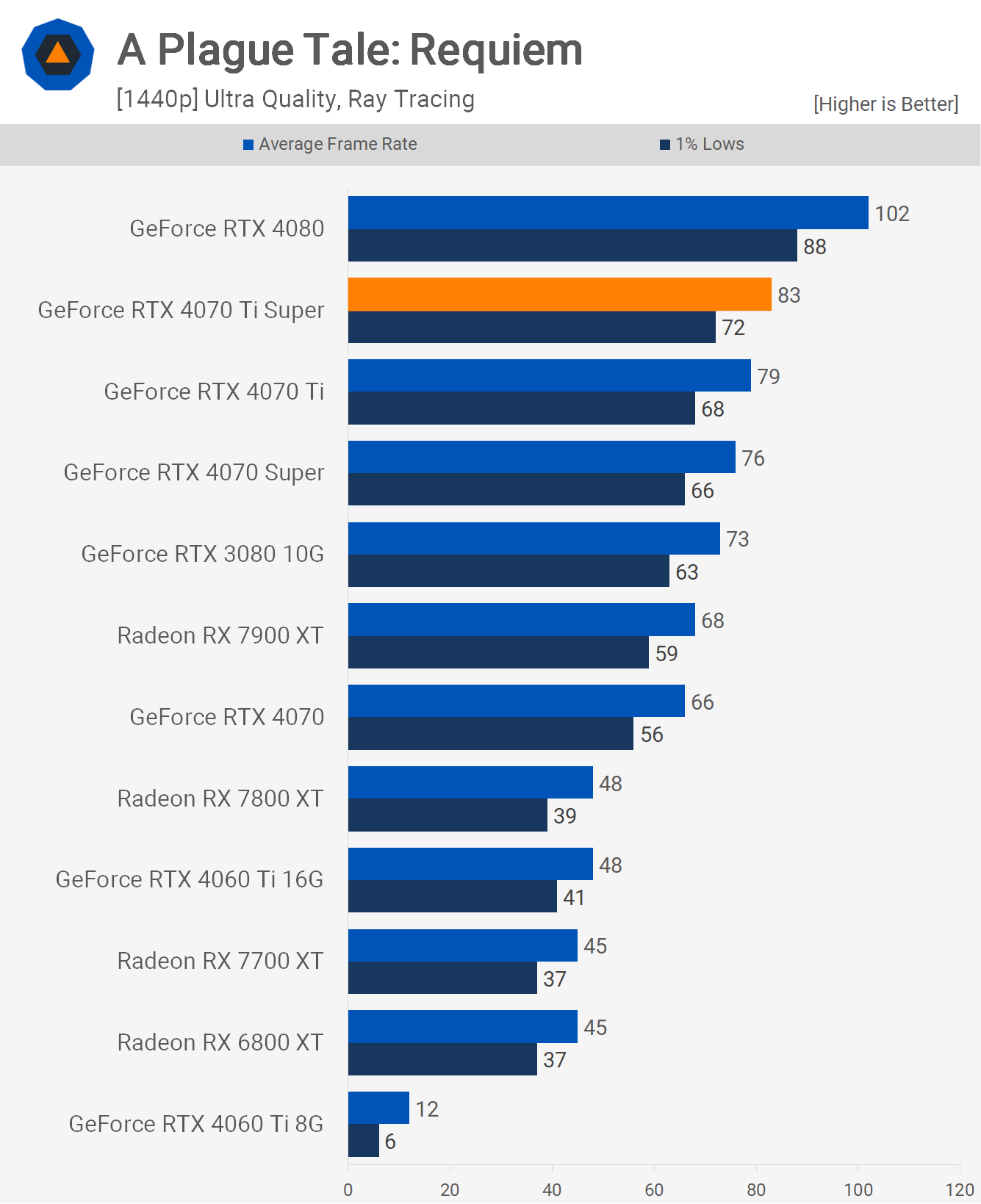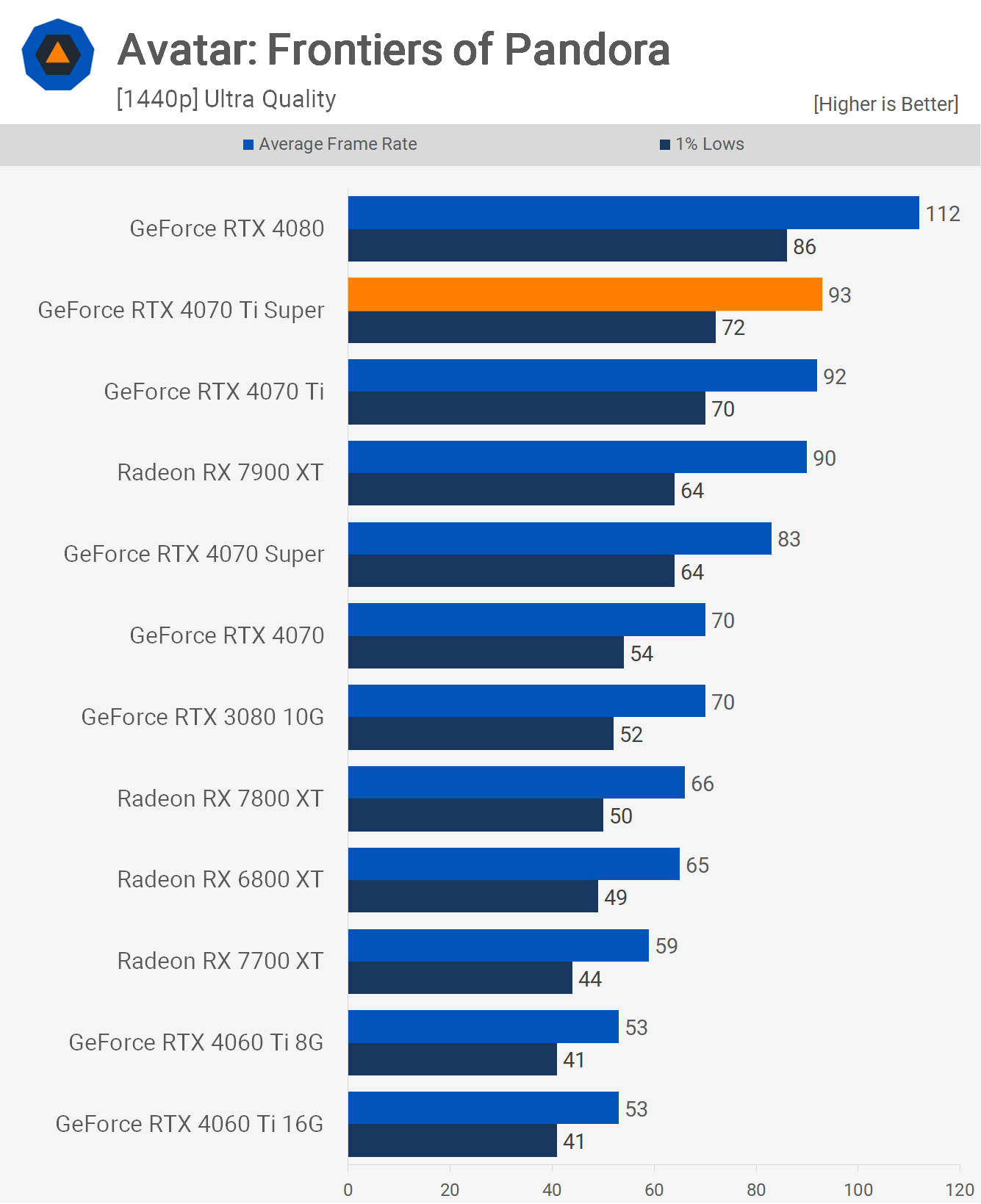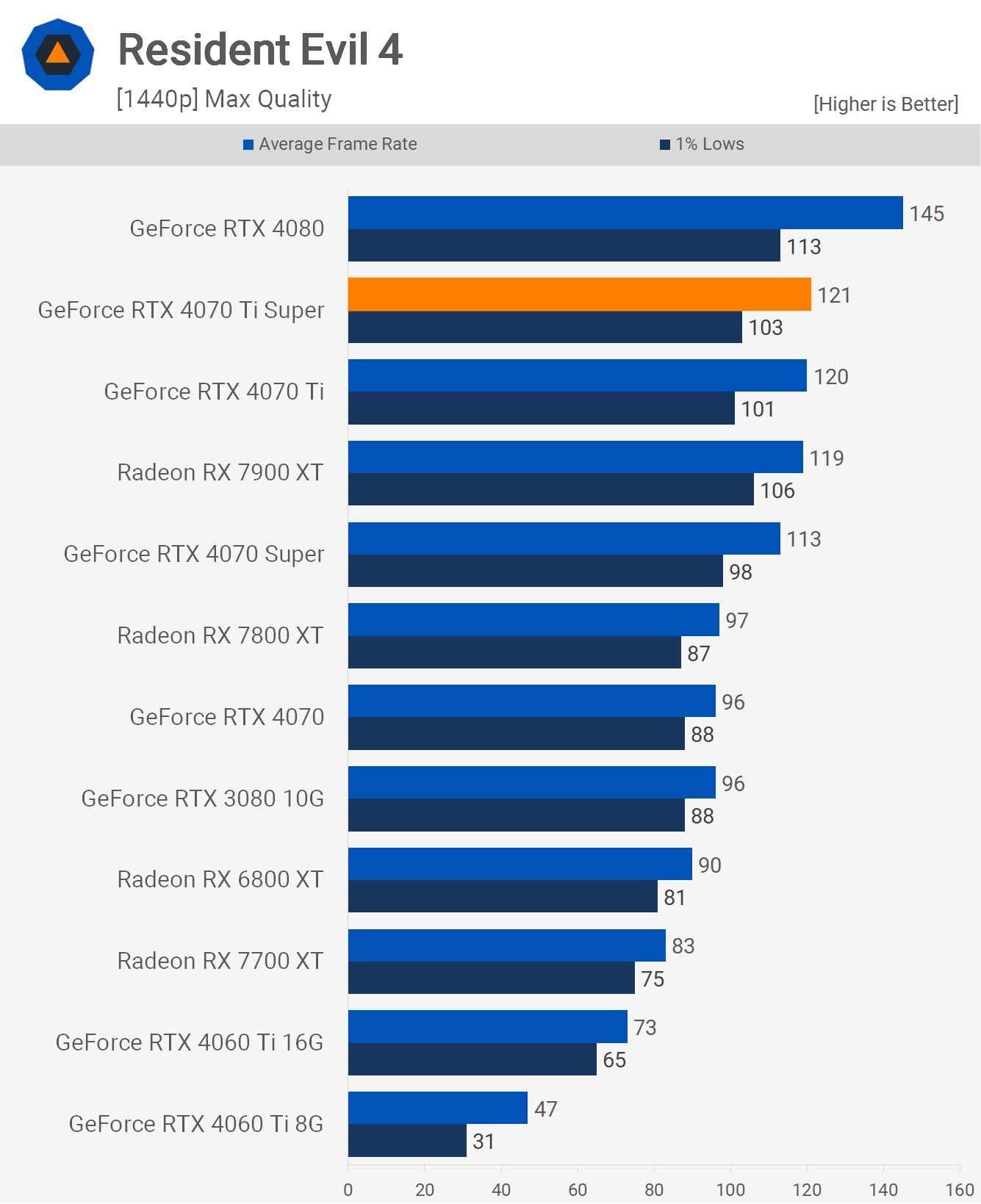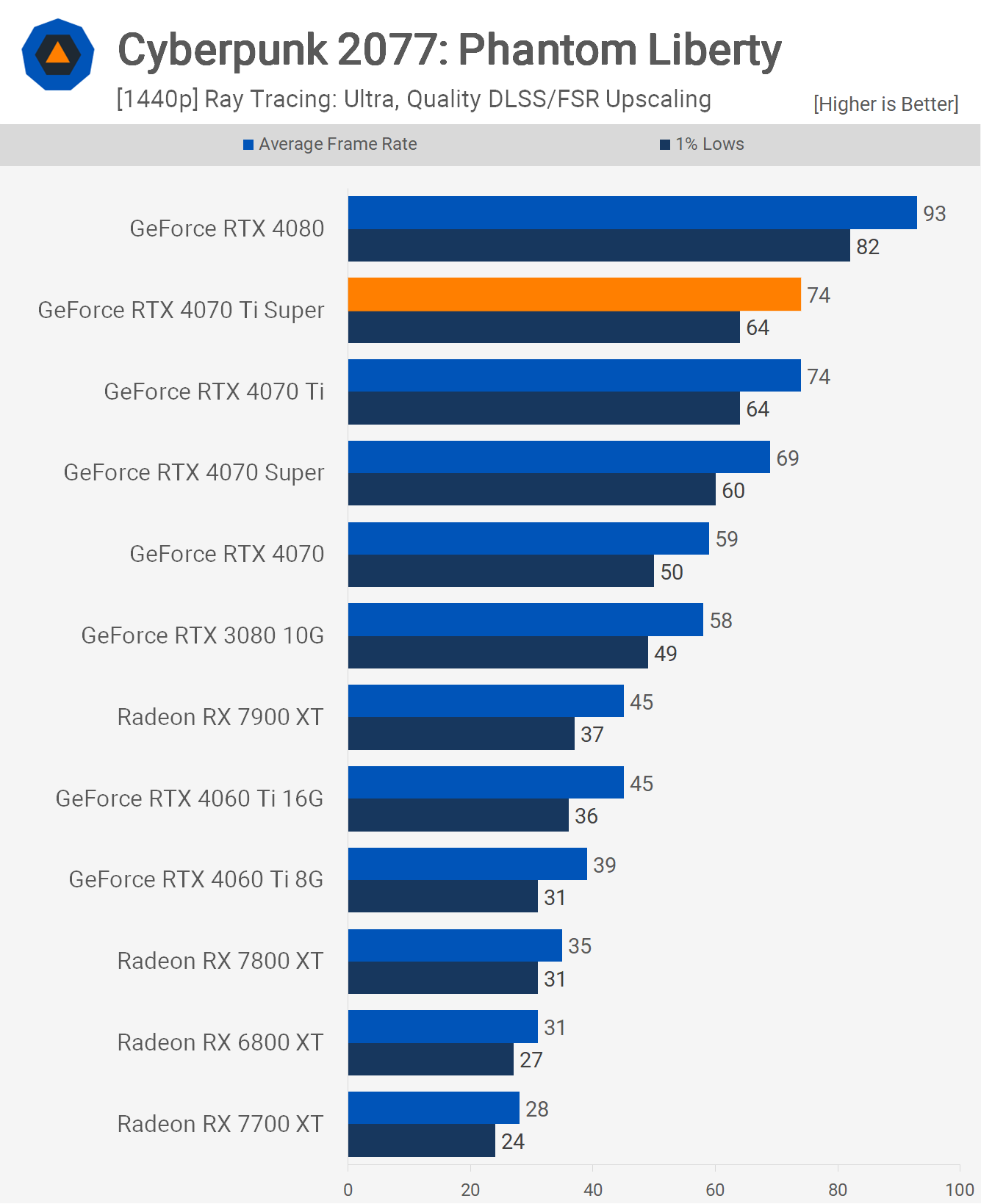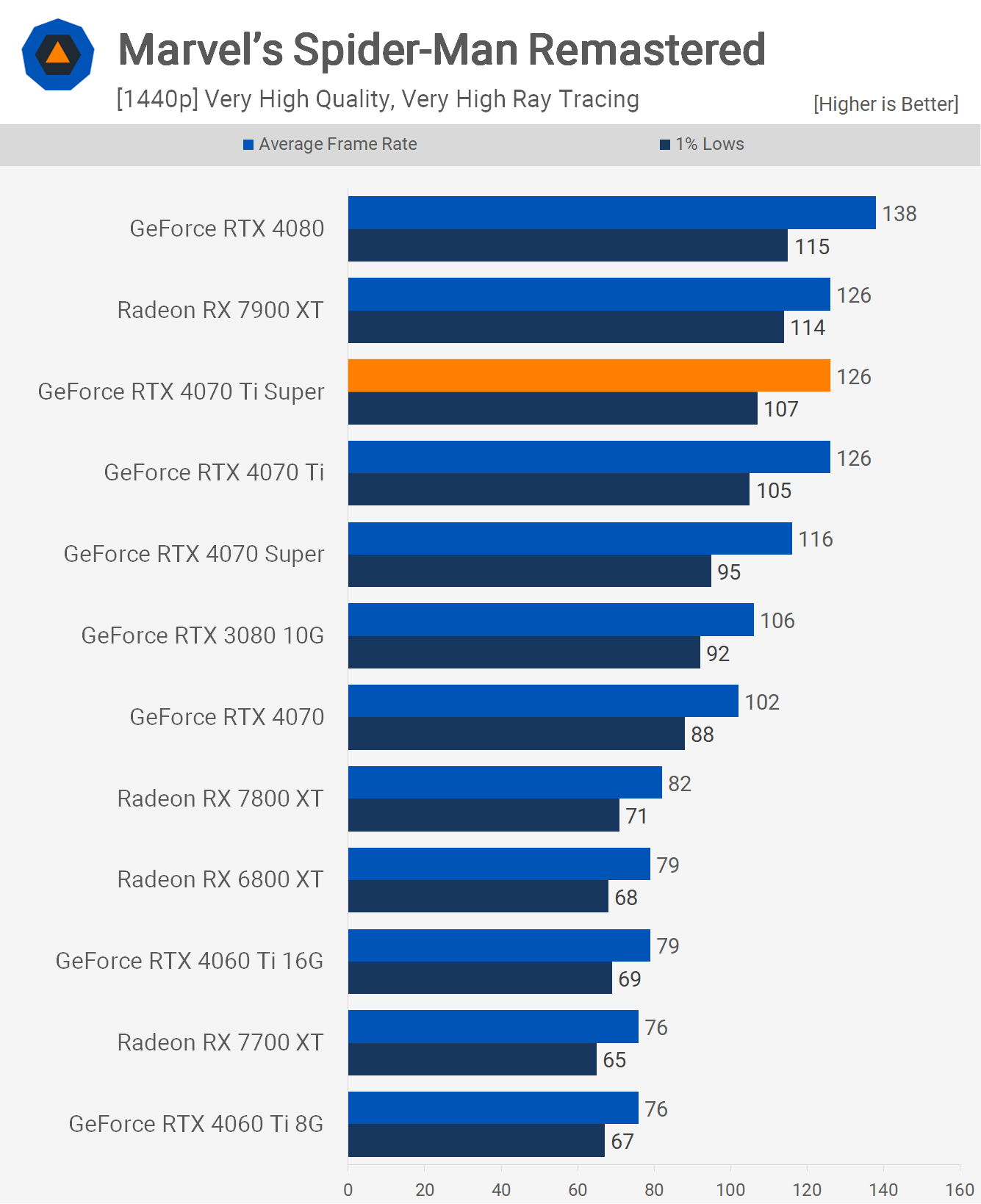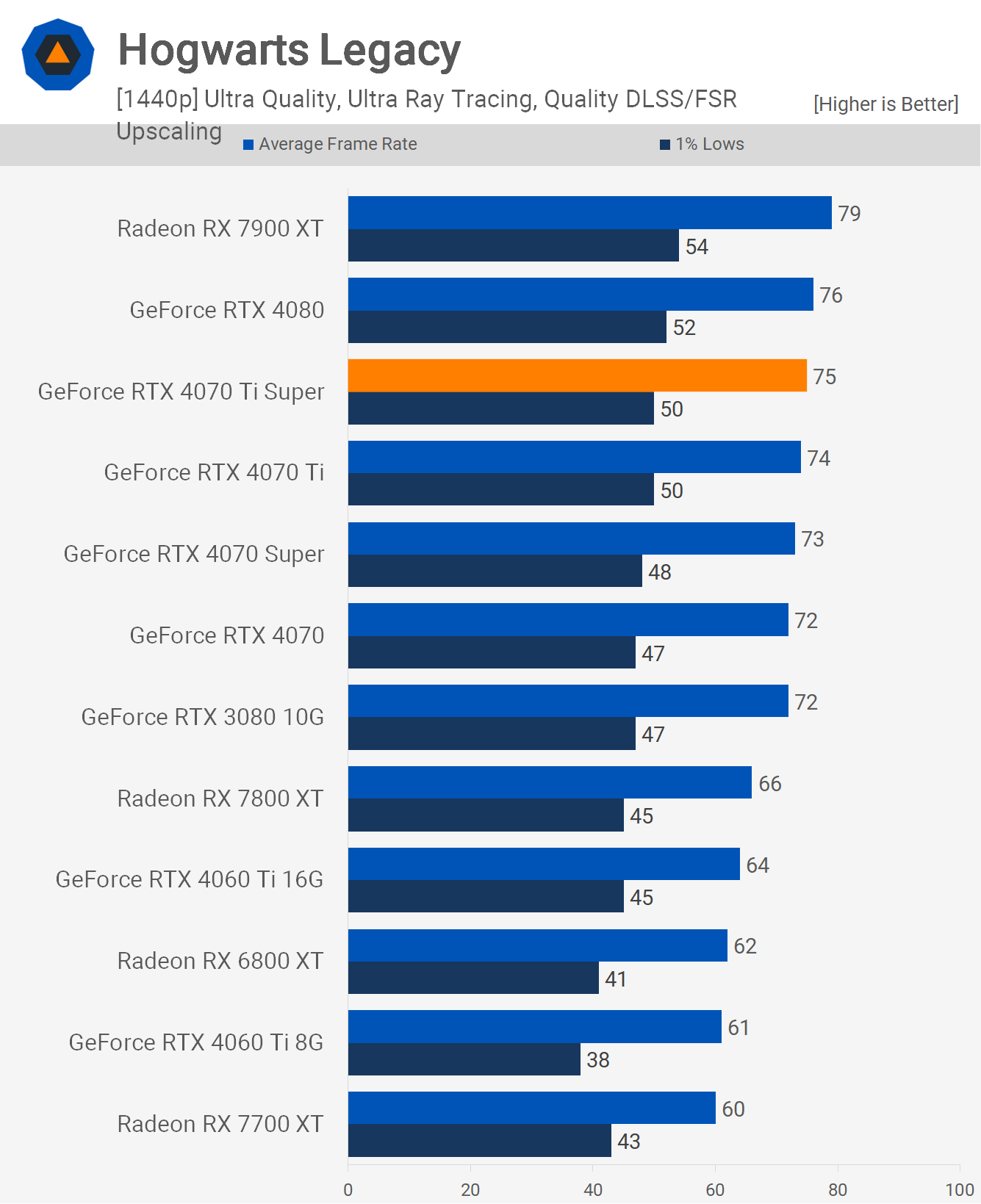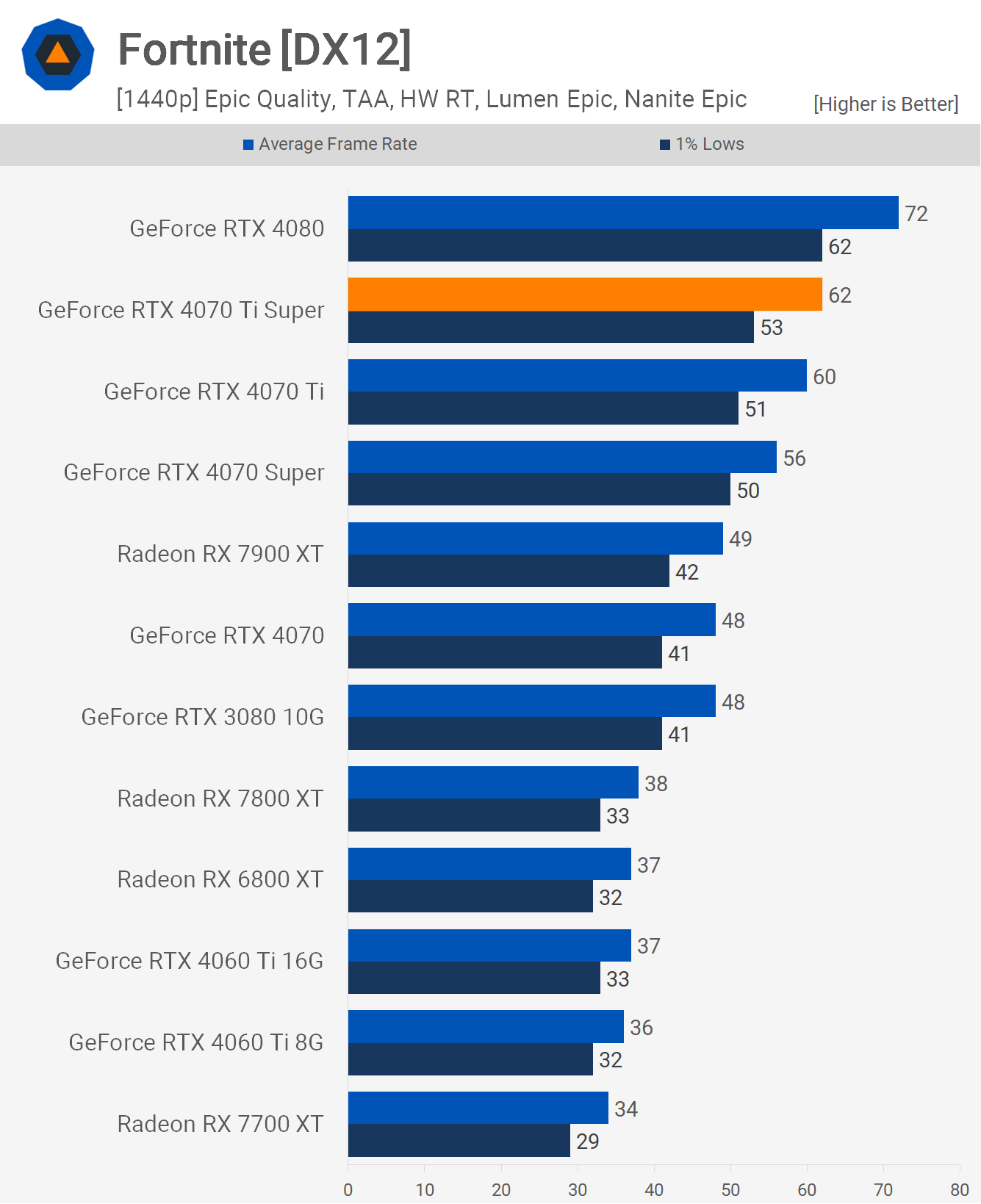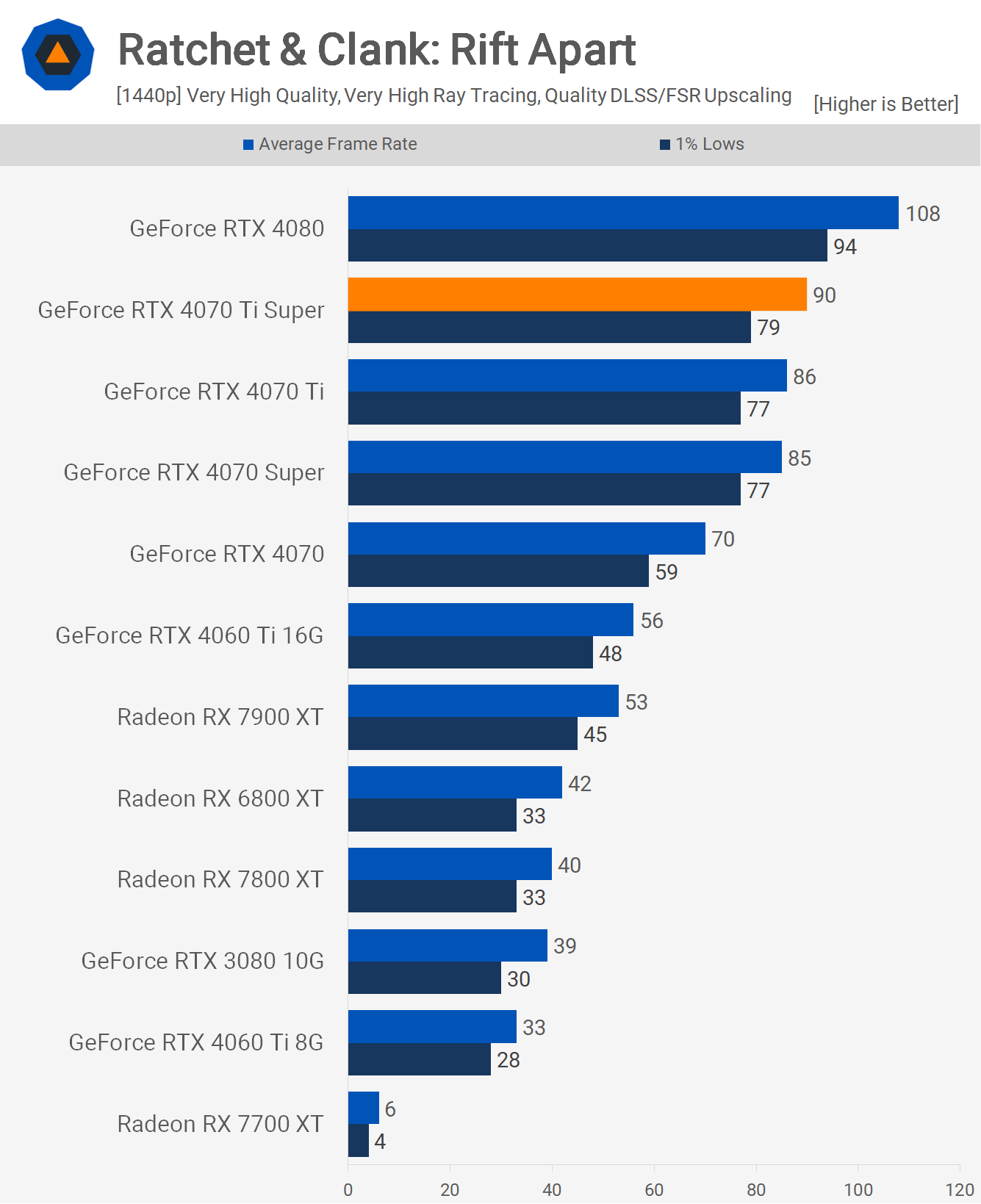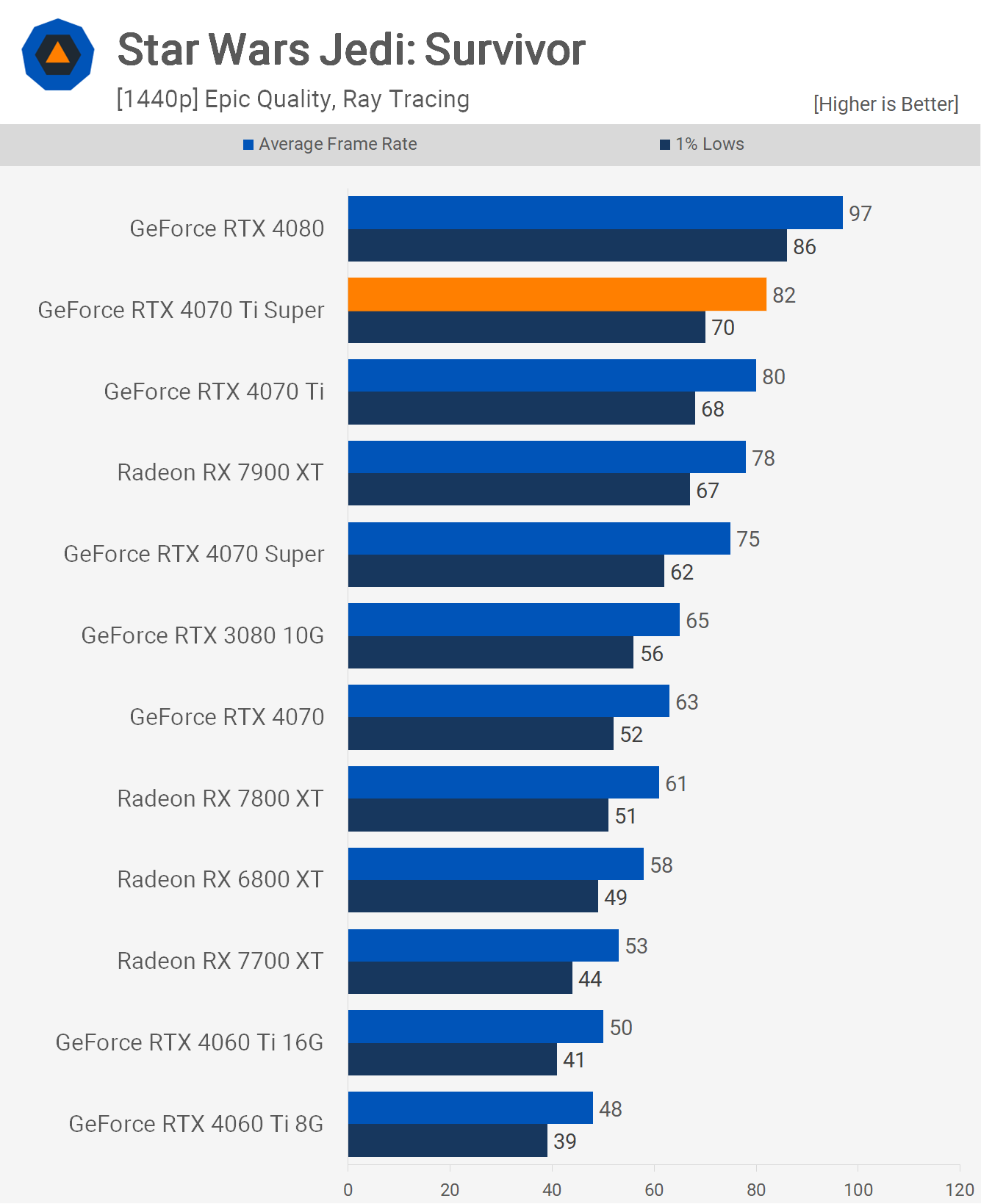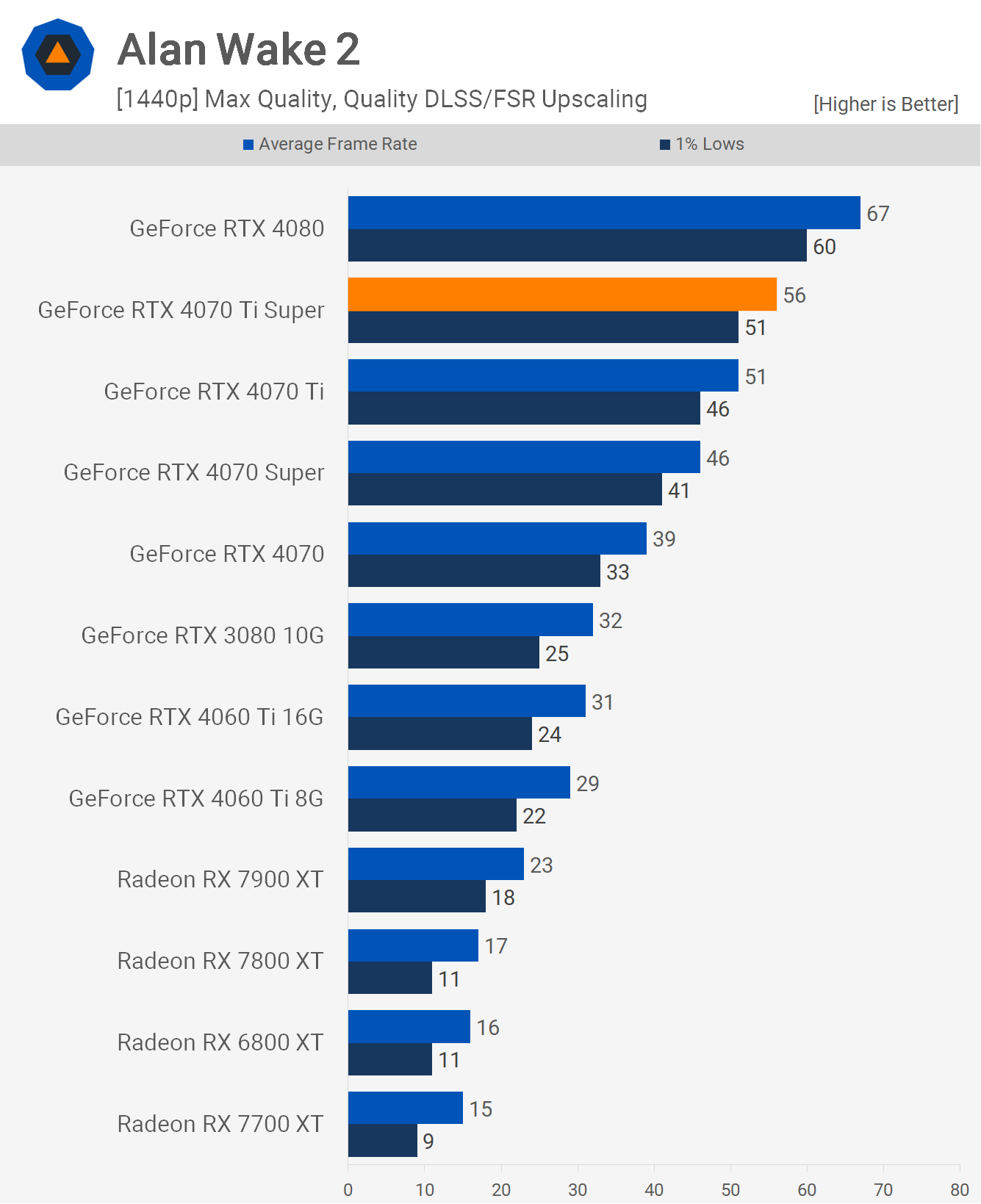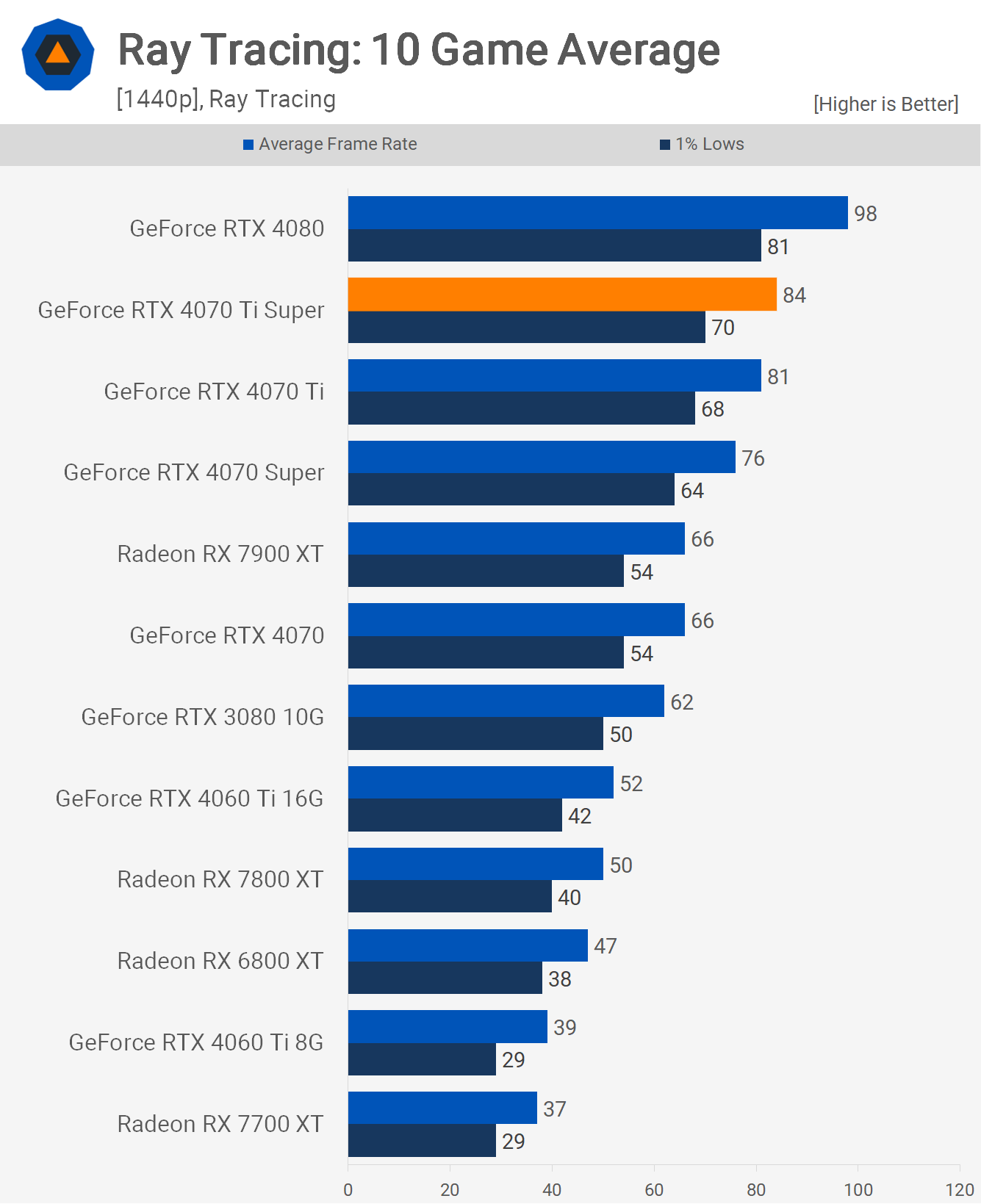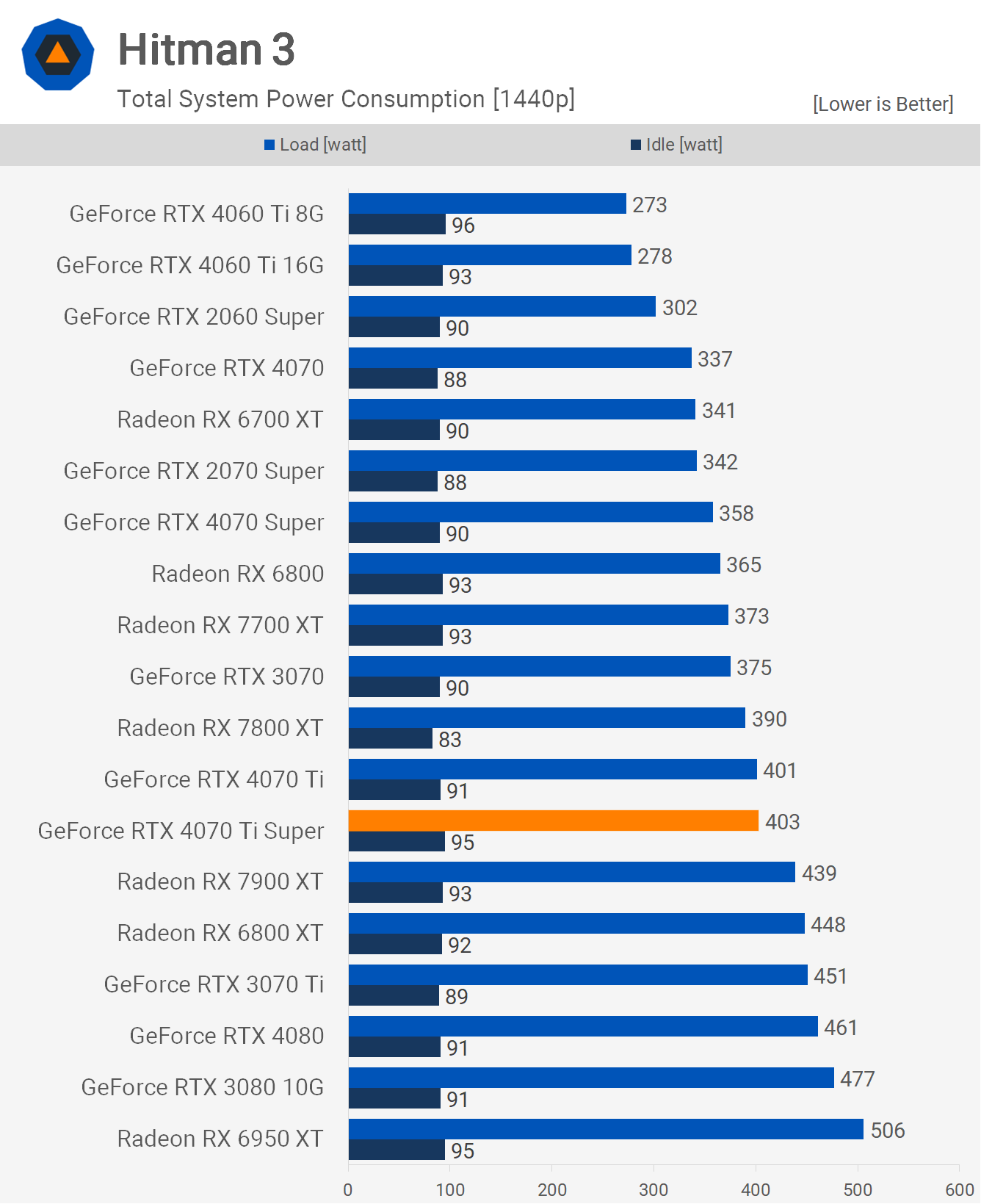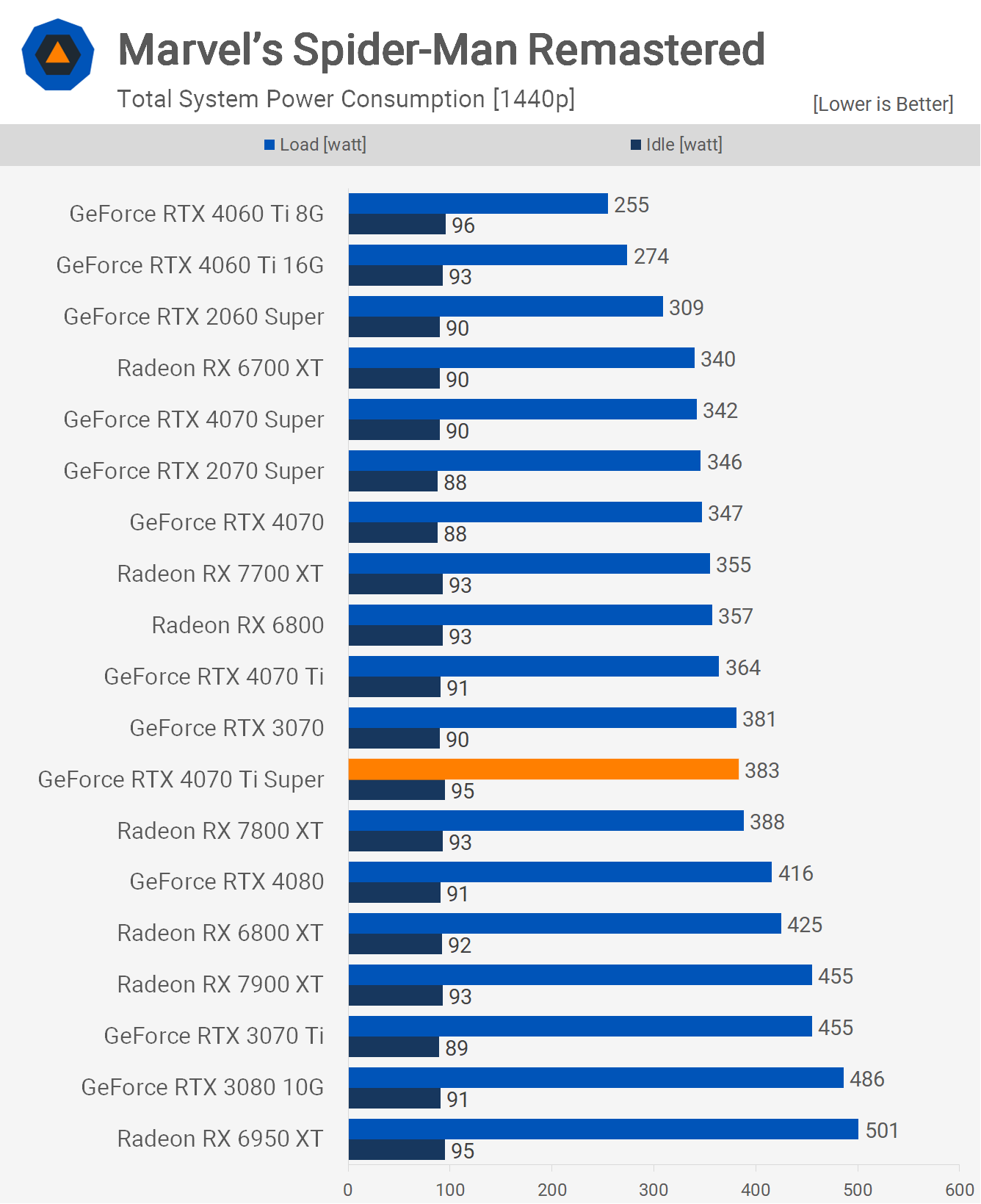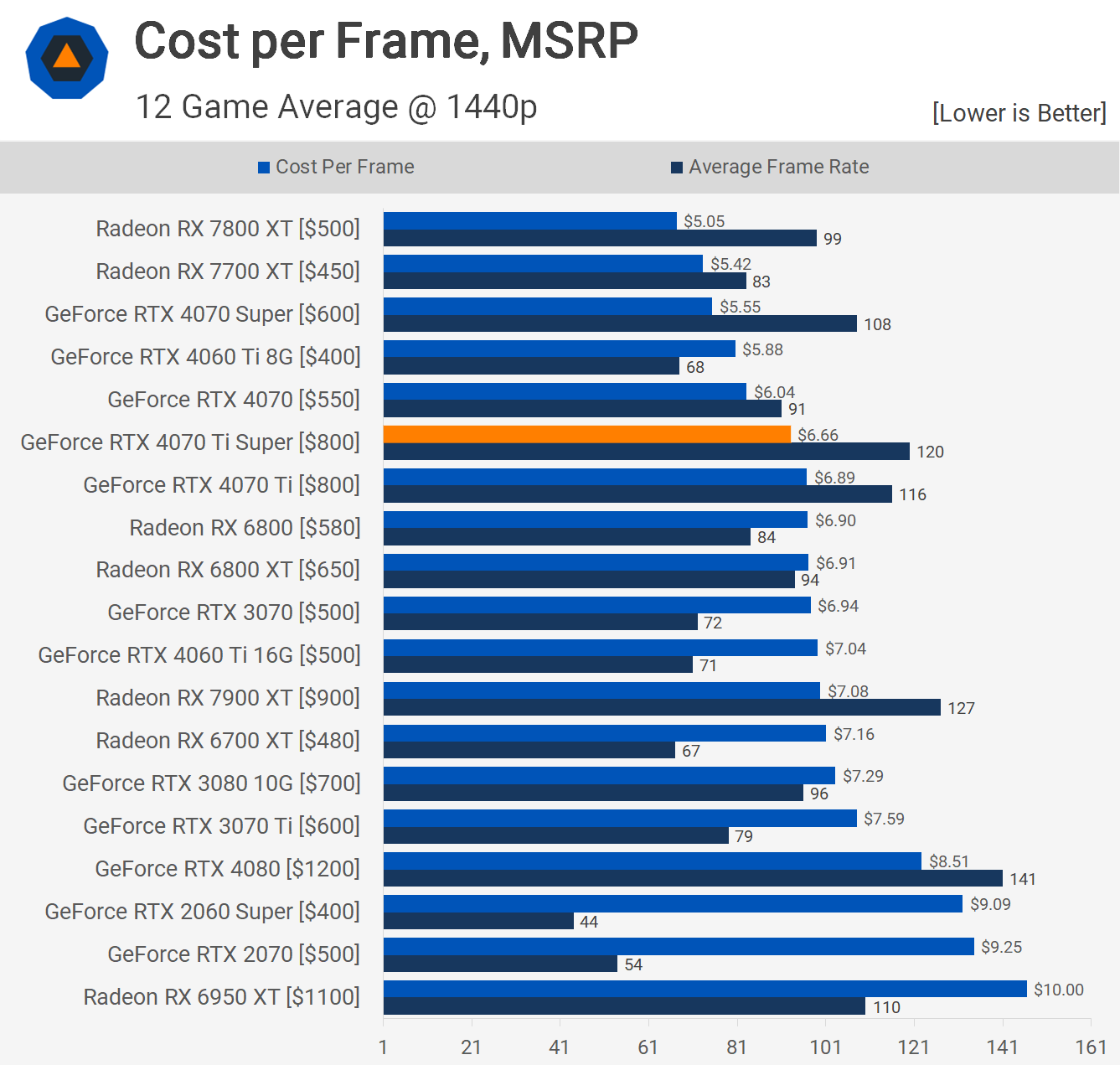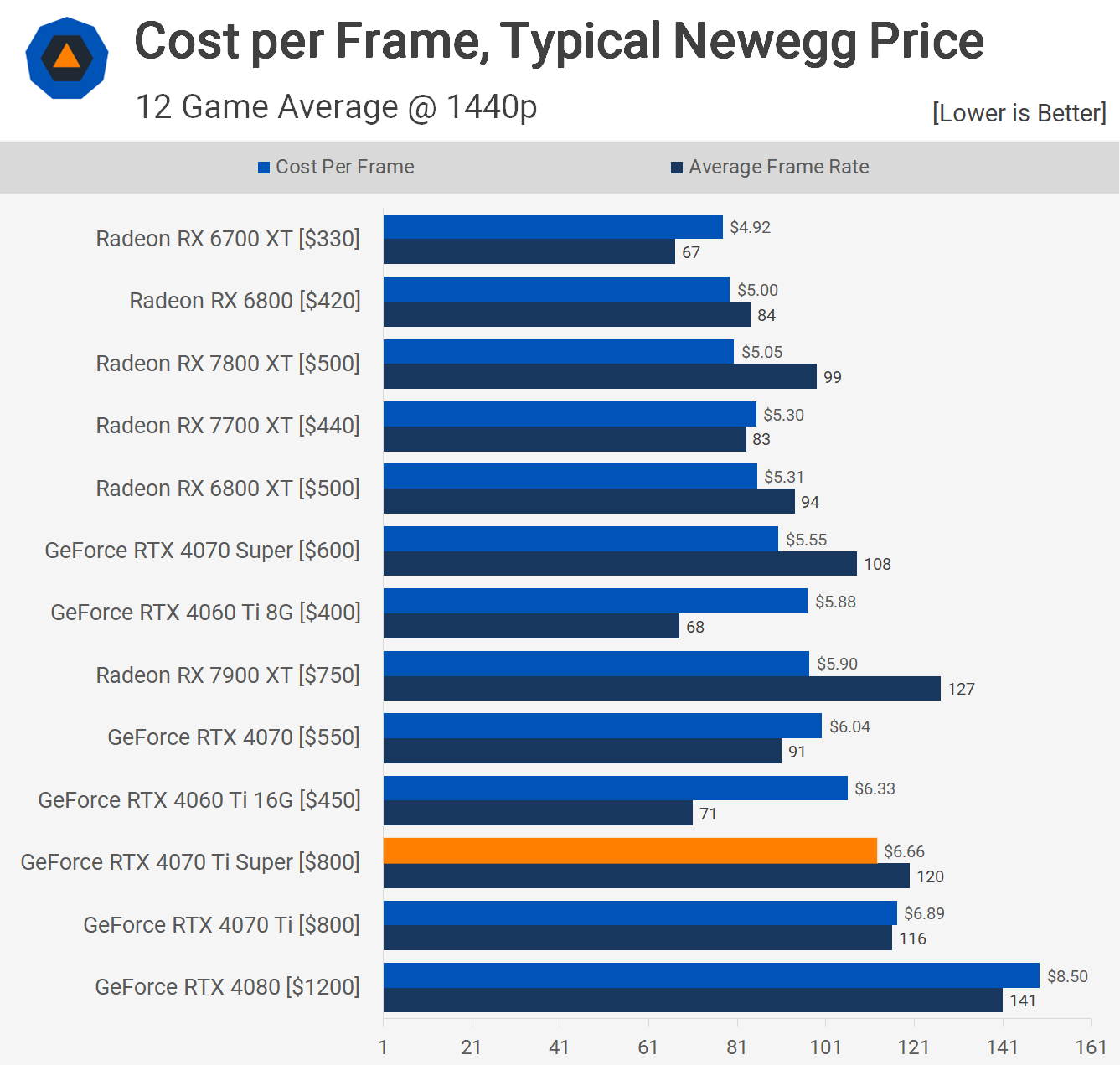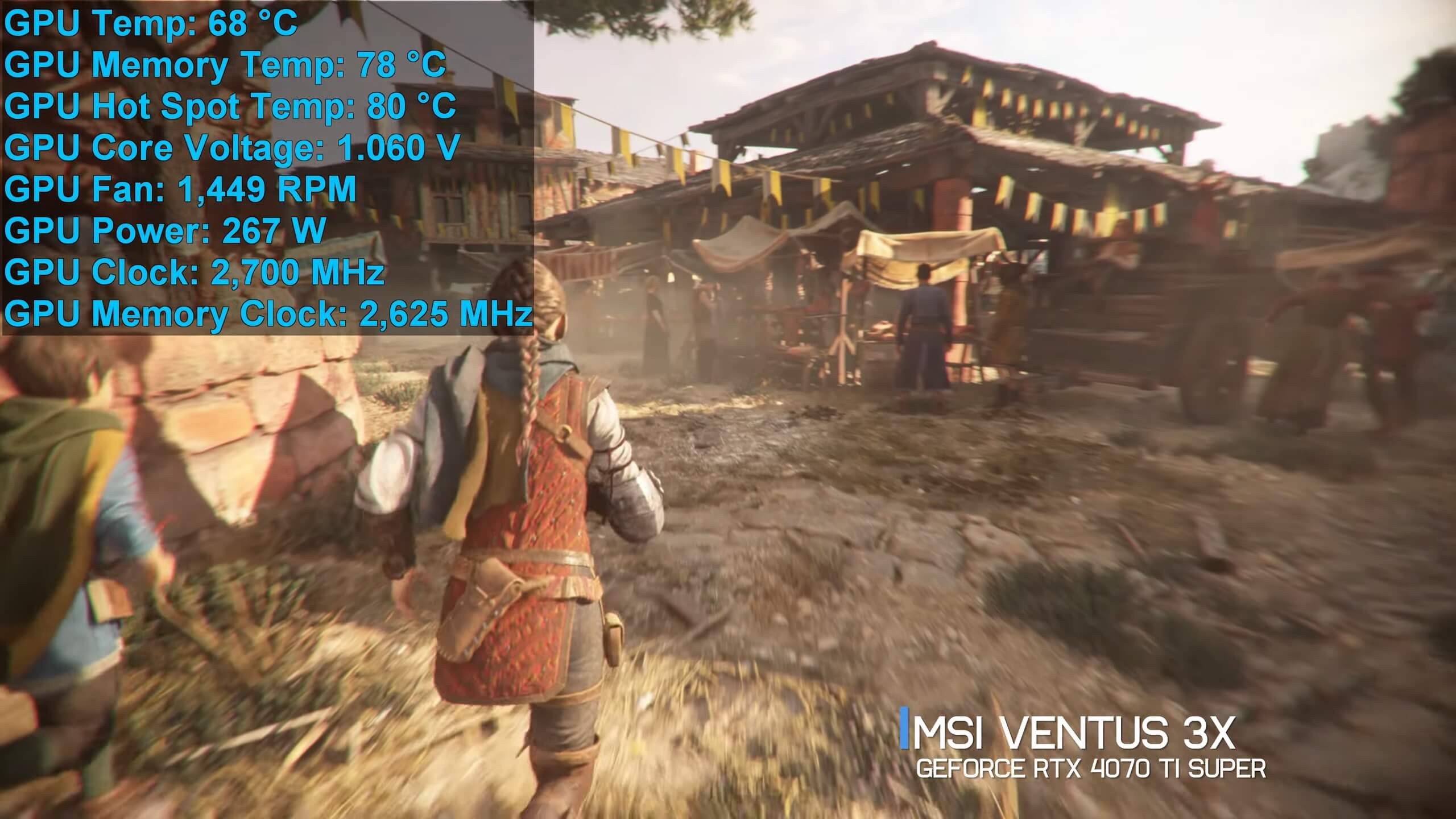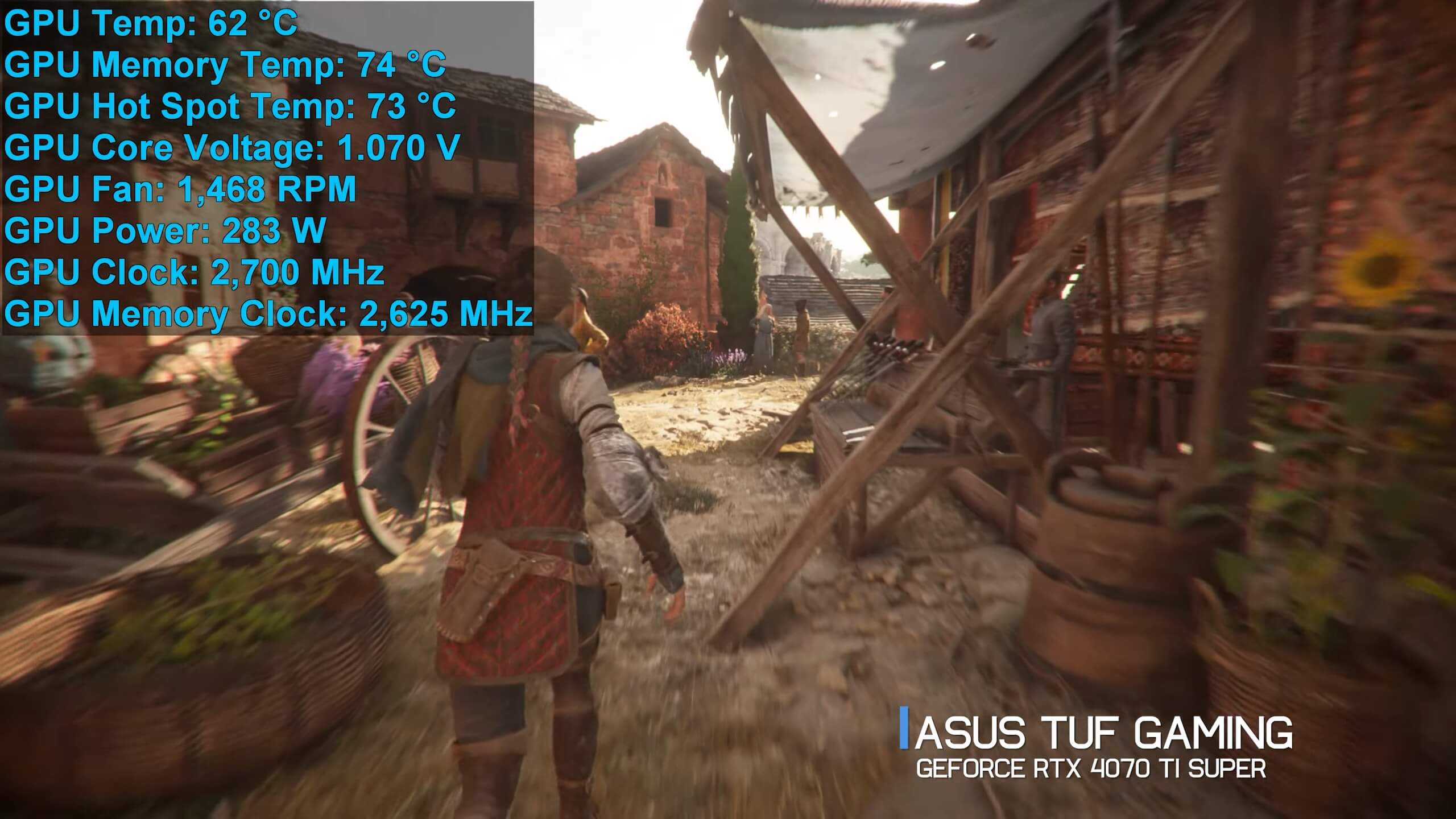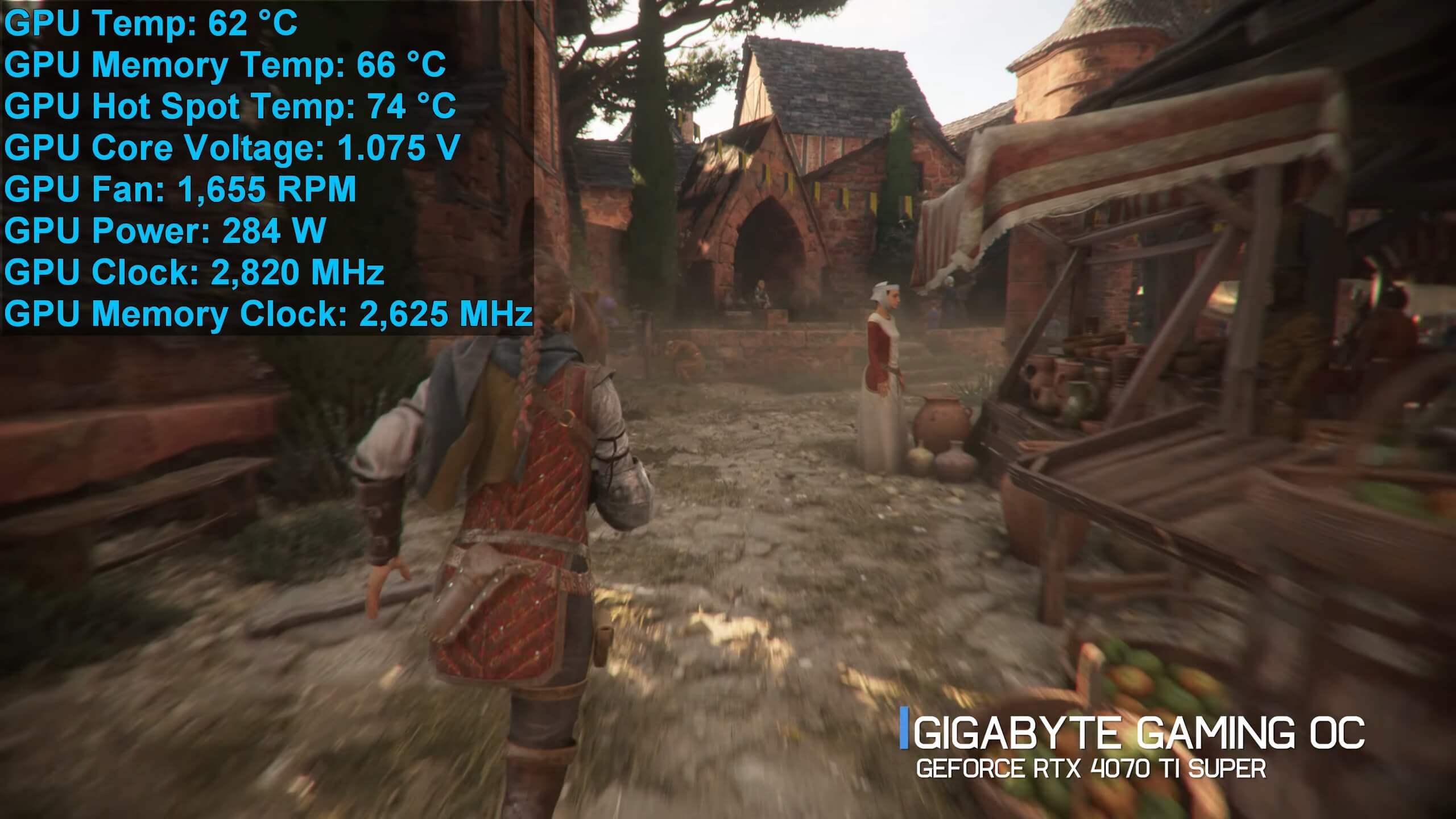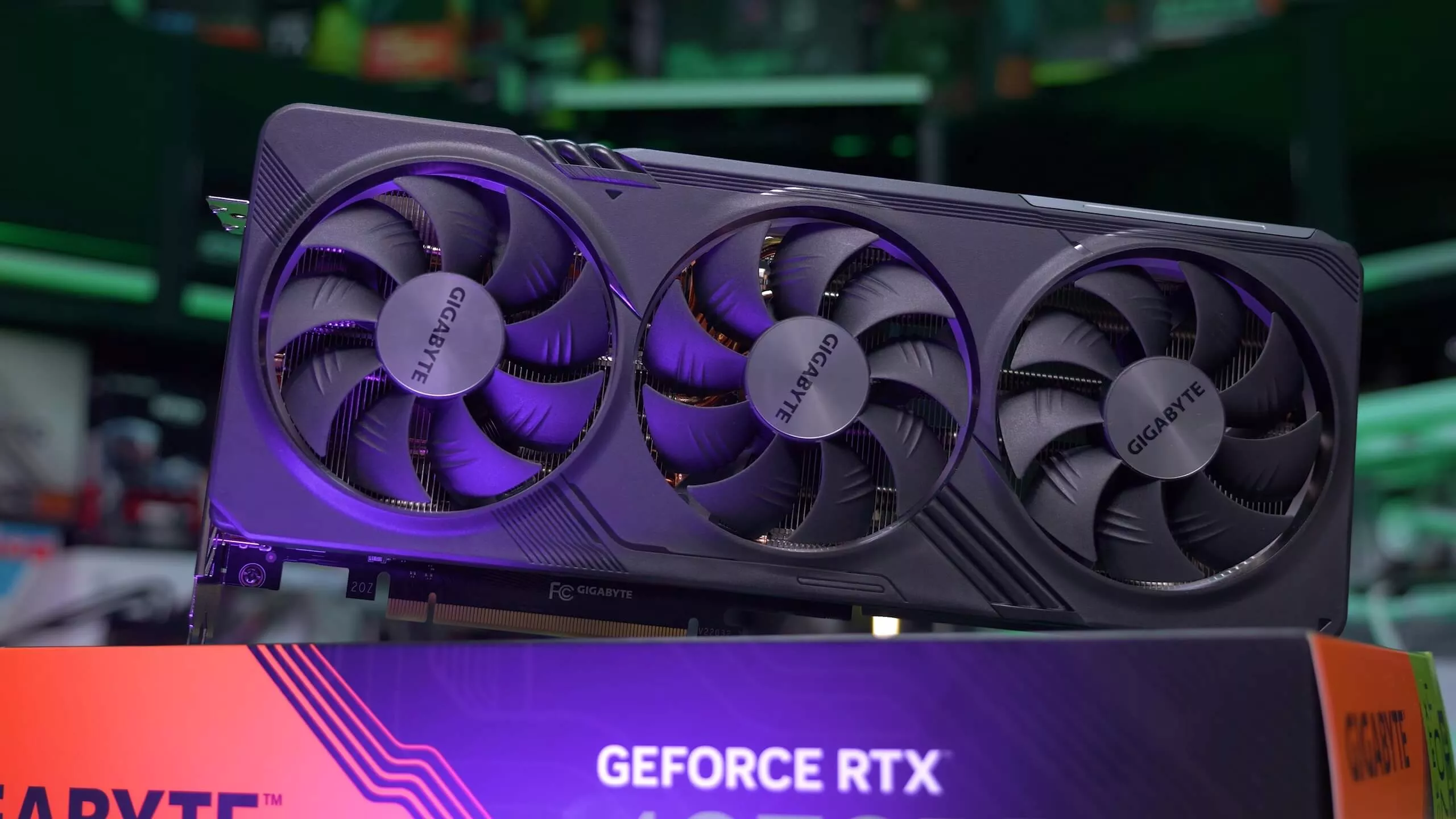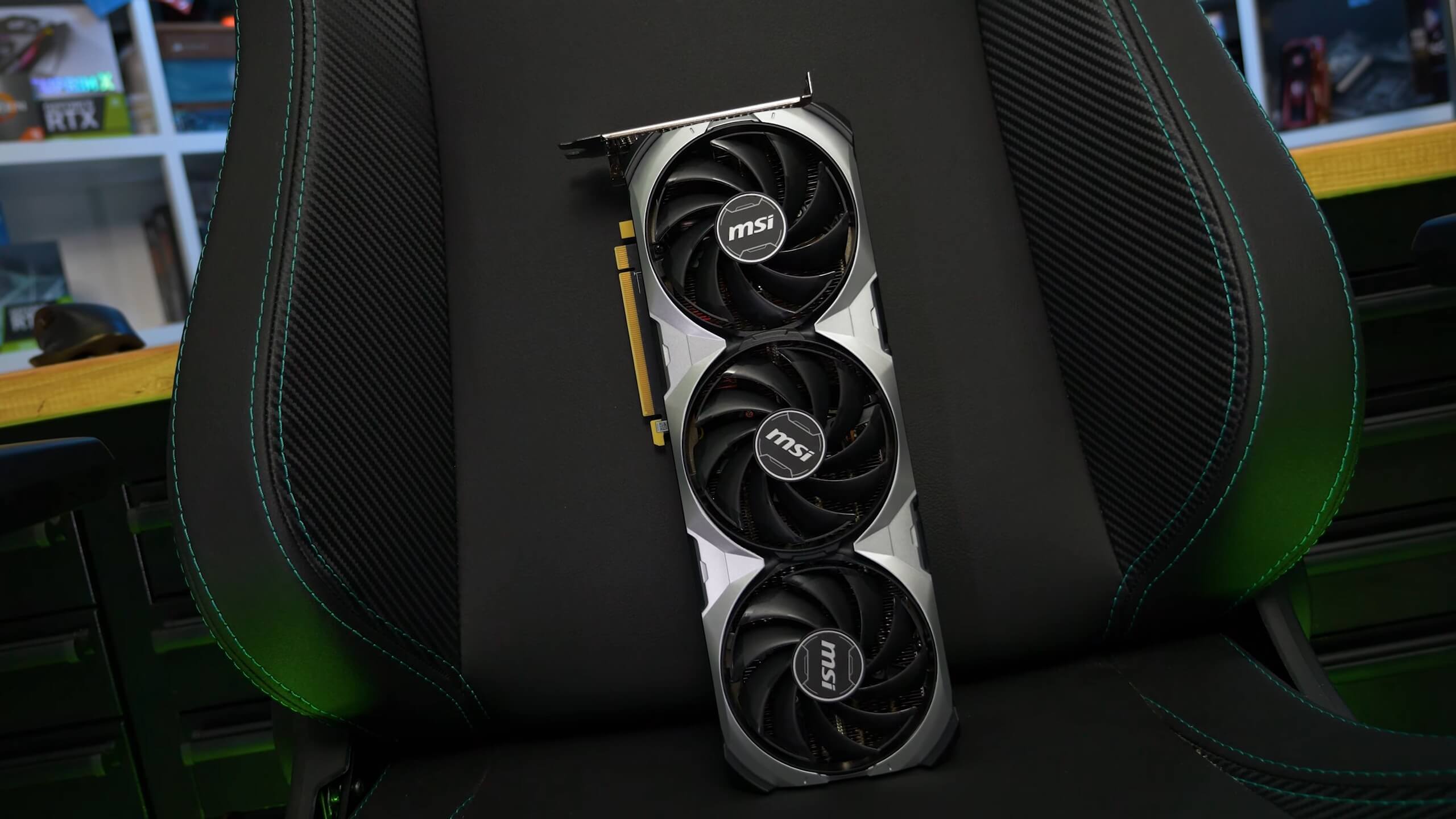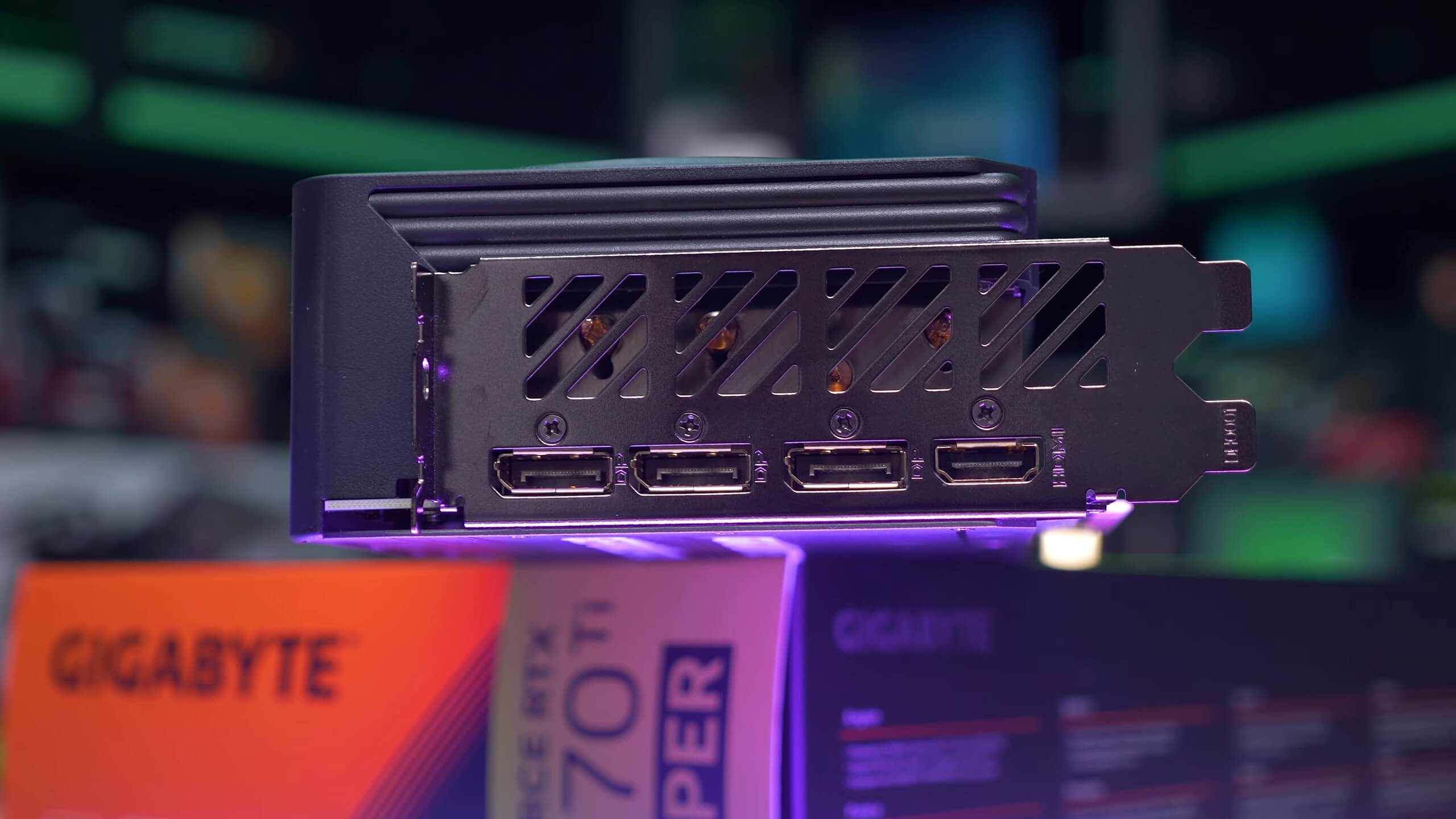The new Nvidia GeForce RTX 4070 Ti Super is so bizarrely named that you'd be forgiven for thinking it's a meme, but no, the Ti Super is a thing, and as silly as it sounds, the specs look pretty great. We're talking 16GB of VRAM using AD103 silicon, indicating strong performance potential.
Unlike other RTX 4070 class products, the 4070 Ti Super moves away from the AD104 silicon and instead uses the same AD103 silicon as the RTX 4080. This change results in a 10% increase in CUDA cores compared to the original RTX 4070 Ti, falling somewhere in-between that and the RTX 4080. Additionally, it boasts the same 48 MB L2 cache as the original 4070 Ti and 4070 Super.
Whereas the 4070, 4070 Ti, and 4070 Super all use a 192-bit wide memory bus with 12GB of 21Gbps GDDR6X memory for a bandwidth of 504 GB/s, the 4070 Ti Super upgrades to a 256-bit wide memory bus. This allows for a 16GB VRAM capacity, and with higher clocked 22.4 Gbps memory, it achieves a memory bandwidth of 672 GB/s – a notorious improvement.
Based on these specifications, the GeForce RTX 4070 Ti Super should be faster than the 4070 Ti, of course, which is always a reasonable proposition at the same $800 price point. You also get an extra 4GB of VRAM for a total of 16GB, which we believe is particularly valuable at this price level. In fact, it's what we feel should have been the standard for this generation of GPUs.
| RTX 4070 | RTX 4070 Super | RTX 4070 Ti | RTX 4070 Ti Super | RTX 4080 | |
| Price MSRP | $600 | $800 | $1200 | ||
| Release Date | April 13, 2023 | January 17, 2024 | January 5, 2023 | January 24, 2024 | November 16, 2022 |
| Process | TSMC 4N | ||||
| Die Size (mm2) | 294.5 mm2 | 378.6 mm2 | |||
| Core Config | 5888 / 184 / 64 | 7168 / 224 / 80 | 7680 / 240 / 80 | 8448 / 264 / 96 | 9728 / 304 / 112 |
| L2 Cache (MB) | 36 MB | 48 MB | 64 MB | ||
| GPU Boost Clock | 2475 MHz | 2610 MHz | 2505 MHz | ||
| Memory Capacity | 12 GB | 16 GB | |||
| Memory Speed | 21 Gbps | 22.4 Gbps | |||
| Memory Type | GDDR6X | ||||
| Bus Type / Bandwidth | 192-bit / 504 GB/s | 256-bit / 672 GB/s | 256-bit / 717 GB/s | ||
| Total Board Power | 200 watts | 220 watts | 285 watts | 320 watts | |
These upgrades should enable the 4070 Ti Super to more effectively compete with the Radeon RX 7900 XT, which is now commonly available for $750. In terms of rasterization performance, the 7900 XT easily beats the 4070 Ti, and with 20GB of VRAM, it presents itself as a truly high-end option, despite its weaker ray tracing capabilities. In this review we'll take a refreshed look at performance between all these contenders and dive into the cost per frame data.
For our testing, we used a Ryzen 7 7800X3D test system with 32GB of DDR5-6000 memory, and the latest display drivers. All data has been validated and updated for this review. We tested a total of 12 games, some with and without ray tracing, focusing on 1440p and 4K resolutions.
Before delving into the results, a quick note on a last-minute issue: Nvidia informed us, just a day before this review was scheduled to go live, of a potential performance issue with the MSI RTX 4070 Ti Super Ventus 3X GPU, which was concerning as it was the model used for most of our testing.
Nvidia told us that the MSI model's performance was ~5% lower than expected when compared to other AIB models (requiring a firmware update to make it faster). This presented a challenge as our review was nearly complete, and re-testing everything would be time-consuming, not to mention the additional work of updating graphs and editing.
Nevertheless, we dropped everything and decided to investigate by testing the Asus TUF Gaming model that we thankfully also had on hand. After discussions with MSI, they acknowledged mixed reports, with some experiencing little to no difference between the Ventus 3X and TUF Gaming models, similar to our findings, while others observed up to a 5% difference.
Update (Jan 25): After more extensive testing of the MSI graphics card, updated firmware and comparing to other RTX 4070 Ti Super models, our latest findings show at most a 9% increase in performance in one title at a specific resolution (Hogwarts Legacy), with most titles showing a less significant difference. We have recorded an average gaming performance uplift of 2% at 1440p and 3% at 4K. Because this is a minor difference, our conclusions for the remainder of this review remain the same as the cost per frame and overall value brought by the 4070 Ti Super is about the same as before.
Given this minimal impact observed in testing, we have kept the original data for this review, as a ~2-3% difference is unlikely to significantly alter the overall findings. However, we plan to update all the RTX 4070 Ti Super data in our upcoming RTX 4080 Super review next week.
Benchmarks
First up, we have A Plague Tale: Requiem at 1440p using the ultra quality preset, but with ray tracing disabled, though we will look at RT results soon. Here, the Ti Super produced 104 fps, making it 7% slower than the 7900 XT and just 5% faster than the 4070 Ti.
Jumping up to 4K, the Ti Super slips further behind the 7900 XT, now trailing by a 9% margin with 60 fps on average.
Next, we have Resident Evil 4, and at 1440p the Ti Super is faster than the 7900 XT, though only by a mere 5% margin. This meant it was just 4% faster than the 4070 Ti, which is somewhat disappointing.
Increasing the resolution to 4K, the 7900 XT takes the lead, though the Ti Super is just 3% slower, so performance overall is basically the same here.
Moving on to Cyberpunk 2077, the Ti Super trails the 7900 XT by a 9% margin at 1440p, though keep in mind we're yet to enable Ray Tracing. Also disappointing is the fact that the 4070 Ti Super is just 3% faster than the original 4070 Ti.
Increasing the resolution to 4K favors the 7900 XT a little more, and now the Ti Super is 7% slower, though it is also 6% faster than the standard 4070 Ti.
Hogwarts Legacy was tested using the ultra quality preset and at 1440p, the Ti Super is 10% slower than the 7900 XT and disappointingly no faster than the original 4070 Ti.
Then at 4K, it falls behind the 7900 XT by a 14% margin, only matching the old 6950 XT, though oddly it is now 23% faster than the RTX 4070 Ti.
Next up is Call of Duty: Modern Warfare III, tested using the 'extreme' preset. Starting with the 1440p data, the Ti Super is 23% slower than the 7900 XT and bizarrely 4% slower than the 4070 Ti, which frankly shouldn't be possible. We're not the only ones to find this, and apparently, Nvidia is looking into it, so perhaps this is a driver-related issue.
What we found was that the Ti Super was much slower than the standard 4070 Ti at 1080p, a little slower at 1440p, and then slightly faster at 4K. We're not exactly sure what's going on here, but in any case, it's going to land quite a way behind the 7900 XT.
Moving on to Spider-Man Remastered, we find performance that's pretty much neck-and-neck between the 7900 XT and the 4070 Ti Super, with around 200 fps each. That made the Ti Super 9% faster than the standard 4070 Ti and 10% slower than the RTX 4080.
We find much the same at 4K; here the Ti Super was just 2% slower than the 7900 XT and 5% faster than the standard 4070 Ti.
The Last of Us Part I was tested using the ultra preset, and at 1440p, the 4070 Ti Super achieved an average of 100 fps, basically the same level of performance you can expect from the Radeon RX 7900 XT. In this example, that's a 12% boost over the 4070 Ti and just 8% slower than the 4080.
Then at 4K, the 7900 XT and 4070 Ti Super were again neck-and-neck, but we do see a more substantial 17% increase over the standard 4070 Ti.
The Ti Super offers only a very minor performance improvement in Dying Light 2, boosting the 1440p performance by a mere 3%. This resulted in it being 4% slower than the 7900 XT.
Then at 4K, it ends up 6% slower than the 7900 XT and a rather underwhelming 3% faster than the original model.
Next up are the Starfield results. At 1440p, the Ti Super is 6% slower than the 7900 XT and a mere 1% faster than the 4070 Ti, which seems rather inconsequential.
Then at 4K, it's 8% slower than the 7900 XT and again just a single frame faster than the original model, resulting in a 2% uplift.
Alan Wake 2, one of the newest games on our test list, is both visually impressive and demanding on hardware. Using the highest quality preset but with ray tracing disabled, the Ti Super is 6% slower than the 7900 XT at 1440p, mainly because it's just 3% faster than the original 4070 Ti.
Moving up to 4K reduces the average frame rate of the Ti Super to just 41 fps, making it 5% slower than the 7900 XT. It was also only 5% faster than the original 4070 Ti, which makes this updated model seem somewhat redundant.
The second-to-last game tested is Watch Dogs: Legion. Here, the Ti Super is 9% slower than the 7900 XT at 1440p, and just 1% faster than the 4070 Ti.
Then at 4K, it trailed the 7900 XT by a 10% margin with just 94 fps on average, which is a modest 3 fps boost over the original 4070 Ti.
For the last of the rasterization results, we have Hitman 3. Here, the 4070 Ti Super averaged an impressive 172 fps at 1440p, making it 9% faster than the 7900 XT and 8% faster than the 4070 Ti.
Increasing the resolution to 4K completely reverses the results, and now the 4070 Ti Super is 13% slower than the 7900 XT. We're also observing virtually no change in performance between the 4070 Ti and the 4070 Ti Super.
Average Gaming Performance (Raster)
Here's a look at the 12-game average, covering the raster performance. At 1080p, the Ti Super was 6% slower than the 7900 XT and just 3% faster than the 4070 Ti. This is a pretty disappointing result overall.
The margin to the 7900 XT was the same at 1440p, with the Ti Super being 6% slower and just 3% faster than the standard 4070 Ti. Based on this, one has to question the purpose of this model.
Finally, at 4K, it's 9% slower than the 7900 XT and 6% faster than the 4070 Ti, which doesn't quite match the performance increase we were expecting based on the specifications.
Average Gaming Performance (Ray Tracing)
We've overhauled our benchmarks for testing ray tracing performance, adding more titles and increasing the RT settings. The goal was 60 fps or better at 1440p, so if upscaling was required, it was enabled, using the quality setting for either DLSS or FSR.
In A Plague Tale: Requiem, upscaling wasn't necessary to achieve 60 fps or better with the 4070 Ti Super, so we didn't enable it. In this example, it was 22% faster than the 7900 XT, but just 5% faster than the 4070 Ti. While this is a good result relative to the AMD GPU, it's a modest performance uplift compared to the model it's replacing.
For the 4070 Super review, we added Avatar but included it in the 12-game benchmark data, despite the fact that it enables ray tracing by default. After careful consideration, we've decided to move Avatar into our ray tracing benchmarks. Since RT effects can't be disabled in this title, we removed it from the 12-game data.
The 7900 XT performs reasonably well here, as the Ti Super is just 3% faster on average. The Ti Super was also just a frame faster than the 4070 Ti, so the uplift there is smaller than expected.
Next, we have Resident Evil 4, where both the 7900 XT and 4070 Ti Super were good for around 120 fps, showing similar performance. In fact, the Ti Super is really no better than the original, which is puzzling.
Cyberpunk 2077: Phantom Liberty was tested using the Ray Tracing Ultra preset, which requires the aid of upscaling for 60 fps gaming. We've enabled quality DLSS for the GeForce GPUs and quality FSR for the Radeon GPUs.
Unfortunately, the 7900 XT couldn't achieve a 60 fps average, rendering just 45 fps. The 4070 Ti Super, on the other hand, produced 74 fps, which was the same result as the standard 4070 Ti.
Spider-Man Remastered was tested using the very high quality preset with very high quality ray tracing options. Despite maxing the game out, we find that the 7900 XT and 4070 Ti Super are neck and neck with 126 fps, the same performance as the standard 4070 Ti.
Performance in Hogwarts Legacy is somewhat CPU-bound, even at 1440p, which indicates poor optimization. As a result, most higher-end GPUs produce similar performance.
The RTX 4070 Ti Super doesn't require upscaling to exceed 60 fps in Fortnite at 1440p with all ray-traced features enabled. As a result, it was 27% faster than the 7900 XT, rendering 62 fps compared to 49 fps.
Ratchet & Clank: Rift Apart is a challenging title for AMD once ray tracing is enabled. In this example, the 7900 XT fell short of 60 fps, even with FSR enabled. Meanwhile, the 4070 Ti Super achieved 90 fps using DLSS quality mode, making it 70% faster than the 7900 XT, a significant margin.
We're unsure why the 7700 XT struggles in this title with RT enabled. We tried multiple driver installs, but each time the game significantly slowed down. This seems like a driver bug, which hopefully AMD will address soon.
Star Wars Jedi: Survivor performs better with Radeon GPUs once ray tracing is enabled, as we see similar performance between the 7900 XT and 4070 Ti Super, with around 80 fps on average.
Finally, we have Alan Wake 2, which is extremely challenging for AMD. While the rasterized performance is excellent from the Radeon GPUs, enabling ray tracing severely hampers them to the point where even upscaling can't make them viable. As a result, the 4070 Ti Super was almost three times faster than the 7900 XT.
Average Gaming Performance (Ray Tracing)
Here's a look at the 10-game average for ray tracing gaming at 1440p. The GeForce RTX 4070 Ti Super is on average 27% faster than the 7900 XT, a rather disappointing result for the Radeon GPU. It's no surprise to find Nvidia leading the ray tracing benchmarks, though the extent of their advantage does depend on the games selected.
Alan Wake 2, for example, was a tough challenge for AMD and certainly helped to inflate the margins. It's also a great looking game that is playable using ray tracing on the 4070 Ti Super at 1440p, making it a valid result in our view.
The only disappointing aspect here is the fact that the Ti Super is just 4% faster on average than the original 4070 Ti.
Power Consumption
Another significant advantage of the GeForce 40 series is power efficiency. In Hitman, for example, the 4070 Ti Super was 9% faster than the 7900 XT at 1440p, and yet it managed to reduce total system power usage by 8%. While it's not significantly outperforming the 7900 XT, it's certainly the more efficient product.
Taking power readings while testing Spider-Man Remastered, the RTX 4070 Ti Super reduced total system consumption by 16%, while delivering the same level of performance. A 72-watt power saving is certainly noteworthy.
Cost per Frame (MSRP)
Now it's time for the all-important cost per frame data, starting with the MSRP figures. Although the 7900 XT's MSRP is still $900, it hasn't been priced at $900 for a long time, basically since release. Still, without an official change to the MSRP, we have to use $900, making the 4070 Ti Super around 6% better in terms of value per frame.
Not a dramatic difference, but it does make the GeForce GPU a more appealing buy. However, compared to the original 4070 Ti, the new Super version only improves value by a mere 3%.
Cost per Frame (Retail)
But what about real-world pricing? For that, we have Newegg. The first thing we want to address is the Radeon 7900 XT price of $750. Currently, the cheapest 7900 XT on Newegg is a discounted Asrock Phantom Gaming model at just $710, a serious bargain. Then there are a few XFX and Sapphire models at $730, with the rest at $750 or more.
We haven't gone with the $710 or even the $730 prices as we believe these are limited-time deals, meant to undercut Nvidia's Super launch. AMD has indicated they're working with their partners to make $750 the new sweet spot for the 7900 XT, so realistically, this should be the expected price moving forward.
Therefore, we will disregard what we think are temporary prices and go with the more realistic long-term price of $750. That said, we feel this product really needs an official price cut to $700 to become a viable option.
At $750, it's just an 11% saving per frame compared to the 4070 Ti Super, based solely on rasterization performance. If we consider the ray tracing data, the 7900 XT ends up costing 19% more per frame, making the GeForce GPU the obvious choice for ray tracing enthusiasts.
The only disappointing aspect of the 4070 Ti Super is that it's just 3% better than the original 4070 Ti in terms of value, which isn't a particularly exciting update. It's also 20% more expensive per frame than the 4070 Super, offering a modest 11% performance uplift for a 33% premium.
Cooling Performance
MSI Ventus 3X
For all our testing, we used the MSI Ventus 3X version of the 4070 Ti Super, as it was the first model we received. This base model card should be available at the $800 MSRP. It was installed inside an ATX case, with a room temperature of 21°C, and placed under gaming load for an hour.
After an hour, the junction temperature peaked at 69°C, while the GPU hotspot reached 81°C. The memory also peaked at 82°C, and these temperatures were achieved with a fan speed of 1,400 RPM, resulting in an operating volume of just 32 dBA, making the Ventus 3X a quiet graphics card. The core clock speed averaged 2,700 MHz, and the memory ran at the stock frequency of 2,625 MHz.
Asus TUF Gaming
Also on hand is the Asus TUF Gaming model, which should sell for roughly the MSRP. The 4070 Ti version, for example, currently costs $810, while the OC version is $850. We're big fans of these TUF Gaming models. The all-metal design is very appealing, looking great and feeling premium, a significant step up from the cheap plastic heat spreaders commonly seen.
In terms of operating behavior, it hit a peak junction temperature of just 63°C with a peak hotspot of 75°C, so 6°C cooler than that of the Ventus, with a comparable 1,500 RPM fan speed and 32 dBA fan noise. The memory also peaked at just 76°C, 6°C cooler than the MSI model.
Gigabyte Gaming OC
Lastly, we have the Gigabyte Gaming OC. Currently, the 4070 Ti version is priced $20 over MSRP, so we expect this Super variant to cost at least $820. It showed a peak junction temperature of 63°C and a peak hotspot of 75°C, the same results as the TUF Gaming. However, the memory ran at just 68°C, 8°C cooler than the Asus model and 14°C cooler than MSI's Ventus 3X.
The fan speed did reach 1,600 RPM for an operating volume of 34 dBA, but the cores also clocked at 2,800 MHz, a 4% boost over stock, making it a strong performer for Gigabyte.
What We Learned
Bottom line, the GeForce RTX 4070 Ti Super seems as unnecessary as its name suggests. The card it's replacing, the original RTX 4070 Ti just turned a year old, so it's been on the market for some time. During this period, it's been one of our least favorite products in the GeForce 40 series.
Of course, its biggest issue was the price, or rather what you were getting for that price. $800 for a 12GB graphics card was laughably bad when it launched, so we're glad Nvidia has upgraded it to 16GB, but it also feels like it's too little too late. The Super upgrade isn't significant enough to get us excited at the $800 price point.
On the other hand, the updated RTX 4070 Super for $600 is decent. Not an amazing deal, but as far as mid-cycle refreshes go, it was pretty good. The 4070 Ti Super though is a bit of a wet blanket, overall performance is much the same, we're talking about a few percentage points or not enough for anyone to care.
Also consider that the GeForce RTX 4080 will be replaced by the RTX 4080 Super in a week, offering a minor performance bump with $200 knocked off the price. Based on the data we have, this makes the RTX 4070 Ti Super just 6% more affordable per frame compared to the RTX 4080, but 20% more expensive than the 4070 Super.
This means that overall, AD103 products aren't great in terms of value. But if you're considering the 4070 Ti Super, you might as well opt for the 4080 Super, plus you'll enjoy the added benefit of not sounding like you're having a stroke every time someone asks you what GPU you're running?
Now, compared to the Radeon competition, the RTX 4070 Ti Super stacks up rather well. If priced at $750, the Radeon 7900 XT becomes a questionable choice, and we feel paying an extra $50 for the 4070 Ti Super is the better option. You're getting similar rasterization performance with generally much stronger ray tracing performance, especially in titles that heavily utilize RT effects.
Then there's all the other factors we always talk about, such as the quality of DLSS generally being better than FSR, much better ray tracing performance, superior encoder quality, and better power efficiency, to name a few. For us to choose the Radeon 7900 XT over the GeForce 4070 Ti Super, it would have to be priced at no more than $700, so a $100 saving or a 13% discount.
As we've said countless times, in our opinion, which is backed by reader polling, Radeon GPUs need to be priced at a minimum of 10% less than their GeForce counterparts to become viable options, considering the factors just mentioned. So for us, a 10% lower price is where Radeon becomes viable, 15% less is convincing, and 20% less is an automatic purchase.
We'll continue to monitor pricing with our monthly GPU price updates, so you can determine the best deal for yourself. But for now, the new RTX 4070 Ti Super is a pretty boring product that merely corrects the mistakes of the original and should have been what Nvidia delivered 12 months ago.
